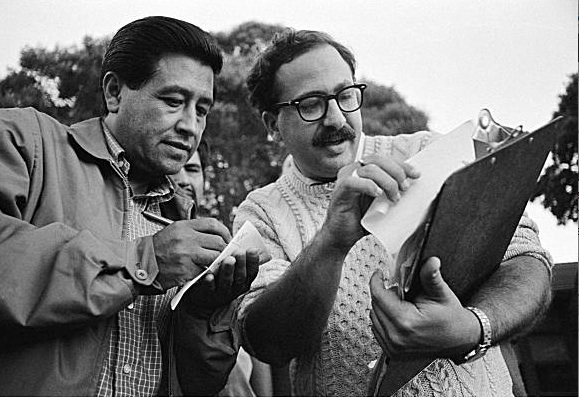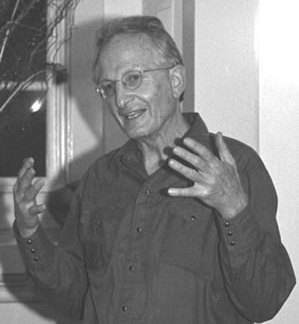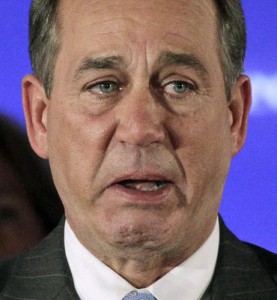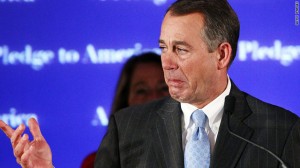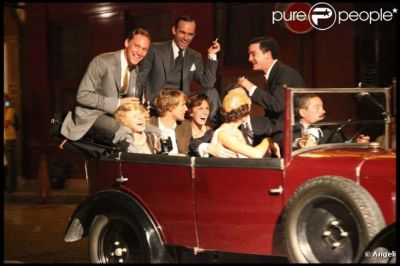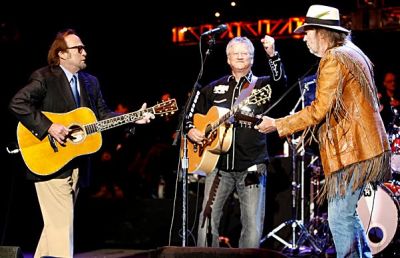Lenin’s Rope: Universities Help Disrupt Universities
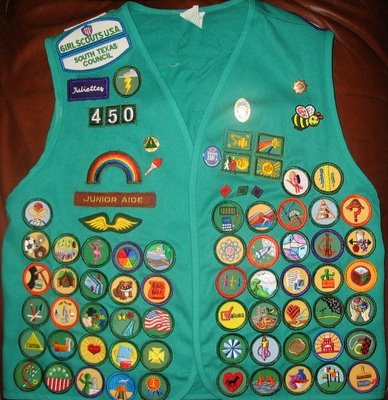 Lenin famously bragged that "Capitalists will sell us the rope with which we will hang them." It would surely gall him to learn that the art of destroying capitalists with their own products has been mastered not by a militant, vanguard-led proletariat but by entrepreneurial capitalists. It appears that even universities, finally, are getting the hang of it and learning to sow the seeds of their own destruction.
As an earlier post detailed, universities rarely go out of business. This is thanks to the magic of a three part lock that secures their position and protects them from institutional challenge. For centuries, universities have enjoyed the exclusive right to allocate valuable social capital.
Lenin famously bragged that "Capitalists will sell us the rope with which we will hang them." It would surely gall him to learn that the art of destroying capitalists with their own products has been mastered not by a militant, vanguard-led proletariat but by entrepreneurial capitalists. It appears that even universities, finally, are getting the hang of it and learning to sow the seeds of their own destruction.
As an earlier post detailed, universities rarely go out of business. This is thanks to the magic of a three part lock that secures their position and protects them from institutional challenge. For centuries, universities have enjoyed the exclusive right to allocate valuable social capital.
- Select talent. There is no evidence at all that Stanford, Harvard, or Berkeley do a better job of training undergraduates than Ohio State, Texas A&M, or the University of Florida. But they select far stronger students. If colleges were assigned students randomly, the value of "elite" degrees would plummet overnight. Harvard delivers 90% of its value the day it admits a student, although the market recognizes the value only when the student graduates. In a previous post, I described an experiment I once proposed to compare students admitted to Harvard Business School who attended with those admitted who did not attend. Others have since confirmed what we all know: Berkeley selects strong students, it does not create them. You aren't smart because you went to Berkeley; you went to Berkeley because you were a certain kind of smart.
- Credential talent. College degrees confer professional access and mobility. Since mobility is "path dependent" (your current options are constrained by past decisions, even if past circumstances are no longer relevant), it matters enormously what choices a credential opens up for you. Take it from a factory worker who went to Harvard Business School.
- Signal social standing. Signaling is a cousin of credentialing. A credential is a specific signal to the labor market that a person completed a course of study and mastered a body of knowledge. But it is relevant mainly early in a career. The broader social and economic signal conferred by a university degree extends well beyond the time when the details of the course work are forgotten. An honors degree from the University of Maryland confers standing, especially in Baltimore, that extends well beyond the knowledge gained from a degree in European History. There are very few signals of social standing as powerful as a college degree, even though very little evidence suggests that this should be the case. Powerful alumni affiliations reinforce this effect.
 Under the Mozilla Open Badge framework, a badge "is a symbol or indicator of an accomplishment, skill, quality or interest" used to represent skill or achievement. Badges support a wide variety of learning beyond traditional classrooms including online courses, after-school programs, as well as work and life experiences. Badges not only signal achievement to peers, potential employers, educational institutions and others, but they are a way to recognize and document informal learning as well. Fully developed, badges should help people transfer learning across jobs, industries, and places and portray a richer, more complete profile of an individual's professionals strengths.
Mozilla expects there to be many types of badges. Some capture specific skills, something traditional degrees do quite poorly. Badges can support specialized and emerging fields that do not yet credential learners. They can document a much larger diversity of skills, social habits, motivations, etc. Badges potentially represent an alternative to traditional degrees as a way to enhance identity and reputation among peers, find peers and mentors with similar interest, formalize camaraderie, teams, and communities of practice that today often form around universities or professional associations.
Open digital badges, unlike the scouting ones, are valuable because of their metadata. They link to videos, documents, or testimonials demonstrating the work that lead to earning the badge. They link to the issuing authority, which can be a school, a professional body, an international credentialing agency, a community of professional practice, a course, or a company. The supporting metadata reduces the risk of gaming and builds in a system of formal or implicit validation. In this system, a digital badge is backed by metadata that explain the badge, the issuer, the issue date, criteria for earning the badge, the earner’s work or evidence behind the badge, and the current validity of the badge, which, unlike a college degree, can be set to expire.
Mozilla is creating an Open Badge Infrastructure to serve as the core technical scaffolding for a badge ecosystem that supports a multitude of issuers, badge earners, and badge displayers. This infrastructure includes the core repositories and management interfaces (each user’s Badge Backpack), as well as specifications required to issue or display badges. Users can build a "Badge Backpack", which serves as a repository for their digital badge data, accessible only to them, where they can view badges, set privacy controls, create groups, and share badges. Startups like BadgeStack, which gamifies badges, can build OBI compliant sites and award apps.
Open badges are a promising idea and one deserving of investigation by companies, entrepreneurs, universities, and investors. They threaten traditional university credentials because they are:
Under the Mozilla Open Badge framework, a badge "is a symbol or indicator of an accomplishment, skill, quality or interest" used to represent skill or achievement. Badges support a wide variety of learning beyond traditional classrooms including online courses, after-school programs, as well as work and life experiences. Badges not only signal achievement to peers, potential employers, educational institutions and others, but they are a way to recognize and document informal learning as well. Fully developed, badges should help people transfer learning across jobs, industries, and places and portray a richer, more complete profile of an individual's professionals strengths.
Mozilla expects there to be many types of badges. Some capture specific skills, something traditional degrees do quite poorly. Badges can support specialized and emerging fields that do not yet credential learners. They can document a much larger diversity of skills, social habits, motivations, etc. Badges potentially represent an alternative to traditional degrees as a way to enhance identity and reputation among peers, find peers and mentors with similar interest, formalize camaraderie, teams, and communities of practice that today often form around universities or professional associations.
Open digital badges, unlike the scouting ones, are valuable because of their metadata. They link to videos, documents, or testimonials demonstrating the work that lead to earning the badge. They link to the issuing authority, which can be a school, a professional body, an international credentialing agency, a community of professional practice, a course, or a company. The supporting metadata reduces the risk of gaming and builds in a system of formal or implicit validation. In this system, a digital badge is backed by metadata that explain the badge, the issuer, the issue date, criteria for earning the badge, the earner’s work or evidence behind the badge, and the current validity of the badge, which, unlike a college degree, can be set to expire.
Mozilla is creating an Open Badge Infrastructure to serve as the core technical scaffolding for a badge ecosystem that supports a multitude of issuers, badge earners, and badge displayers. This infrastructure includes the core repositories and management interfaces (each user’s Badge Backpack), as well as specifications required to issue or display badges. Users can build a "Badge Backpack", which serves as a repository for their digital badge data, accessible only to them, where they can view badges, set privacy controls, create groups, and share badges. Startups like BadgeStack, which gamifies badges, can build OBI compliant sites and award apps.
Open badges are a promising idea and one deserving of investigation by companies, entrepreneurs, universities, and investors. They threaten traditional university credentials because they are:
- Granular. Employers care what you can do; they care relatively little about what you study, except as an indicator of what you can probably do. Badges are likely to reflect specific skills ("architecting social media databases" or "PHP"). Some may complement licensure ("palliative care nursing") others may document skills in areas where little certification is available today ("Thai cooking" or "cloud-based SQL database administration").
- Open. To work, badges need an approval process and an ontology that reflects a hierarchy of skills. An licensed vocational nurse may be able to earn a badge in discontinuing intravenous drips, but I'd prefer that the Thai cook obtain his or her LVN certification before tackling this skill. Once these structures and privacy controls are established, the technology for making badges machine readable, searchable, embeddable, and portable is relatively trivial.
- Able to evolve. The structure of badges itself needs to be open. Today "Thai Cooking" may be a sensible badge. Tomorrow it may be "Kitchen safety and peppers" (I worked with a cook who accidentally sent 50 diners choking and gasping out the door, hospitalizing two of them for lack of this knowledge). Badges that are ten years old will frequently fade in value as others rise. Badges create a market in skill certification -- precisely what should replace university degrees.
- Cumulative. A single badge may or may not signal a great deal, but a sash full of badges accumulated over many years of effort makes you an Eagle Scout. Employers are very likely to value particular combinations of badges for specific jobs. Today, resumes or transcripts do a notoriously poor job of communicating these capabilities.
- Essential to reputation markets. Badges form core elements of emerging reputation marketplaces, where professionals collect, curate, and disseminate information that reflects their professional skills and achievements much as Fair-Isaac today distributes information about your credit history. For some positions (VP Marketing for a startup, for example), leadership history may matter more than a documented set of specific skills, but badges will still contribute to the overall picture.
Draw This…
 Henry Blodget is the former head of Internet research at Merrill Lynch. (Background: once upon a time there was something called Internet research. And once upon a time there was something called Merrill Lynch). NY Attorney General Eliot Spitzer convicted Blodget of touting stocks in public while sending emails disparaging those same securities. Spitzer was later thrown out of office after his foes revealed him to be "Client 9" in an expensive Wall St. prostitution ring. Both men are now exiled from their former professions and both have become media entrepreneurs.
Blodget now leads Business Insider and last night presented a very good piece of research on the growth of mobile to a conference in San Francisco. Towards the end, he describes Draw Something, a game app that has created a buzz around here. Blodget argued that Draw Something, by a startup called OMGPOP, reveals just how explosive the combination of mobile, social, and games can be. He reminded us that Draw Something launched just six weeks ago.
Henry Blodget is the former head of Internet research at Merrill Lynch. (Background: once upon a time there was something called Internet research. And once upon a time there was something called Merrill Lynch). NY Attorney General Eliot Spitzer convicted Blodget of touting stocks in public while sending emails disparaging those same securities. Spitzer was later thrown out of office after his foes revealed him to be "Client 9" in an expensive Wall St. prostitution ring. Both men are now exiled from their former professions and both have become media entrepreneurs.
Blodget now leads Business Insider and last night presented a very good piece of research on the growth of mobile to a conference in San Francisco. Towards the end, he describes Draw Something, a game app that has created a buzz around here. Blodget argued that Draw Something, by a startup called OMGPOP, reveals just how explosive the combination of mobile, social, and games can be. He reminded us that Draw Something launched just six weeks ago.
- It has since been downloaded 20 million+ times. It is the #1 app in 79 countries. It has 12m daily users and generates $100,000 of revenue daily for a small team in New York.
- Users are highly engaged. They drew 3 drawings per second on Feb 12. Two weeks later, they drew 100 times that: 333 drawings per second. 10 days later, it was up to 3,000 drawings per second. Users bring in other users, who bring in even more users. This is what viral growth now looks like on global, Internet scale -- and stories like this are about to become fairly common.
- The resulting growth rate is unhinged. It tool AOL nine years to acquire 1 million users. It took Facebook nine months to earn its first million users. Draw Something did it in nine days.
Peak Apple: Understanding the Foxconn Deal
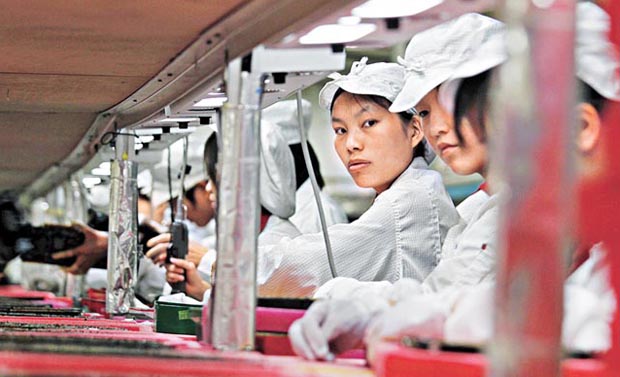 Apple has quickly raised worker wages to address the highly publicized problems with working conditions in its supplier network. The decision protects Apple's pristine brand and costs the company next to nothing. It cleverly exploits the high-minded principles and low-level economic literacy of those of us who are its devoted customers.
A series of well-researched articles by Charles Duhigg in the New York Times that included a long article on sweatshop subcontractors put Apple on the defensive. It appears that hard working people risk their lives to make sure that our iPads are shiny. Apple responded by asking the Fair Labor Association to investigate working conditions at its Chinese suppliers. Back home, Mike Daisey's professional self-immolation magnified the controversy by forcing NPR to retract a series of assertions about Apple's Chinese suppliers. This week, Apple CEO Tim Cook visited a huge Foxconn assembly plant in China as the FLA issued its report. Cook knows a lot about manufacturing both as a global supply chain expert and as a former factory worker.
Cook played the event perfectly. When the FLA reported that, shockingly, Chinese factory workers endure long hours for low pay, he promptly gave workers a raise by pledging to cut hours without cutting pay. The audience applauded, the curtain dropped, and the world returned to its apps.
The story displays a confidence and an ability to turn crisis into yet another advantage that makes me wonder whether we are approaching peak Apple. Apple raised Chinese wages not simply because it cares so much, but because it can afford to care so little. They know that their move causes bigger problems for their competitors than it does for them. Apple cares less about Chinese labor costs than Dell, HP, Google, and many others who produce lower margin products that use more Chinese labor. Apple spends about $8.25 per iPhone on Chinese labor -- a completely irrelevant number in the lifetime economics of an iPhone. Had Chinese workers targeted Apple for a campaign to increase their wages, they would have chosen well.
Is Apple's move good for Chinese workers? Sure -- for some of them anyway. Apple's decision does not mean that Chinese workers will necessarily take home more money -- just that they will work fewer hours. This may not sit well with workers at Foxconn and other subcontractors, most of whom move from the countryside, live in company housing at the factory, and want to maximize their earnings, not minimize their working hours. Duhigg's excellent reporting cited a factory where workers rioted when hours were reduced under pressure from a western customer, acknowledging:
Apple has quickly raised worker wages to address the highly publicized problems with working conditions in its supplier network. The decision protects Apple's pristine brand and costs the company next to nothing. It cleverly exploits the high-minded principles and low-level economic literacy of those of us who are its devoted customers.
A series of well-researched articles by Charles Duhigg in the New York Times that included a long article on sweatshop subcontractors put Apple on the defensive. It appears that hard working people risk their lives to make sure that our iPads are shiny. Apple responded by asking the Fair Labor Association to investigate working conditions at its Chinese suppliers. Back home, Mike Daisey's professional self-immolation magnified the controversy by forcing NPR to retract a series of assertions about Apple's Chinese suppliers. This week, Apple CEO Tim Cook visited a huge Foxconn assembly plant in China as the FLA issued its report. Cook knows a lot about manufacturing both as a global supply chain expert and as a former factory worker.
Cook played the event perfectly. When the FLA reported that, shockingly, Chinese factory workers endure long hours for low pay, he promptly gave workers a raise by pledging to cut hours without cutting pay. The audience applauded, the curtain dropped, and the world returned to its apps.
The story displays a confidence and an ability to turn crisis into yet another advantage that makes me wonder whether we are approaching peak Apple. Apple raised Chinese wages not simply because it cares so much, but because it can afford to care so little. They know that their move causes bigger problems for their competitors than it does for them. Apple cares less about Chinese labor costs than Dell, HP, Google, and many others who produce lower margin products that use more Chinese labor. Apple spends about $8.25 per iPhone on Chinese labor -- a completely irrelevant number in the lifetime economics of an iPhone. Had Chinese workers targeted Apple for a campaign to increase their wages, they would have chosen well.
Is Apple's move good for Chinese workers? Sure -- for some of them anyway. Apple's decision does not mean that Chinese workers will necessarily take home more money -- just that they will work fewer hours. This may not sit well with workers at Foxconn and other subcontractors, most of whom move from the countryside, live in company housing at the factory, and want to maximize their earnings, not minimize their working hours. Duhigg's excellent reporting cited a factory where workers rioted when hours were reduced under pressure from a western customer, acknowledging:
The other (workers) we talked to all seemed to regard it as a plus that the factory allowed them to work long hours. Indeed, some had sought out this factory precisely because it offered them the chance to work more.”Does China benefit from this decision? Not necessarily. Manufacturing jobs are declining China in favor of Vietnam and Cambodia (the great promise of the campaign this week by Nobel Peace Prize winner Aung San Suu Kyi is that Burma will attract urban factories to relieve the punishing life of rural peasants). It surprises many Americans to learn that manufacturing employment in China is actually declining. With the Apple settlement raising labor costs, peasants in adjacent countries can cheer: soon they too can trade in their hoes and hats for a white coats and the opportunity to polish iPads. Nobody said economic progress was beautiful. Apple's decision to polish its "Think Different" brand built on images of Ghandi and Cesar Chavez is tribute to both the company's high moral tone and to it's willingness to indulge the low economic literacy of its Western customers. Apple sells products to people who prefer a world in which every kid can go to college and work eight hour days. Apple customers hate sweatshops, even those that are demonstrable vehicles of economic progress. We have a hard time acknowledging that countries in South Asia, sub-Saharan Africa, or Haiti demonstrably need more sweatshops. We commit what economist Harold Demsetz memorably called the Nirvana Fallacy: we compare the choices facing overseas workers to the alternatives we have, instead of to the alternatives they have. As economist Eric Crampton notes:
Harold Demsetz warned in a beautiful piece of economic writing back in 1969 against what he called Nirvana Theorizing. He said there that we can’t say markets fail just because they deliver outcomes that we don’t like; rather, we have to compare the outcomes of markets to real-world achievable alternatives. We can’t just assume Nirvana on the other side of the scale. And, most of the arguments against sweatshops effectively assume Nirvana on the other side: if only we were to ban sweatshops or, more realistically, impose bans on the import of products produced by sweatshop labour, the employees would suddenly be freed to pursue fulfilling careers or to go and get that Bachelor’s in Cultural Studies that they’ve always wanted..... It’s only the evil sweatshops that are keeping them from achieving their dreams. If only it were that easy. For proper comparative institutional analysis, we really have to look at how working in a sweatshop compares with what else these workers could be doing.Inconveniently for the Nirvana view, thousands of people voluntarily line up outside of Foxconn's gates when factory jobs open up. Those clamoring to work at Foxconn know that factory work is tough and sometimes dangerous. But, like factory workers everywhere, they know that farm work is worse. The Times documented a horrific aluminum dust explosion in a Foxconn plant. This is not something to take lightly (my grandfather, uncle, and kid brother all died on the job or from occupational illness; occupational safety has never been an abstract problem to me), but the risks of factory work are nothing compared to the risk of illness (especially malaria), injury, or poisoning faced by Chinese peasants. Just about everyone who has tried both farm and factory prefers the latter. I worked in several factories; most of the jobs were boring and some were wildly unsafe (I thought for awhile that Westinghouse had a "hire the handicapped" policy because so many of my co-workers were missing fingers or limbs. D'oh). But two days spent harvesting hay under idyllic conditions hurt me worse than any factory job I ever did. Former paper and aluminum mill worker Tim Cook also understands this extremely well.
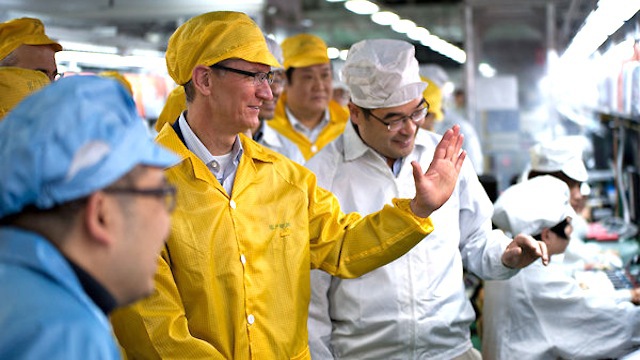 Crampton cites recent work by Benjamin Powell on standards of living associated with sweatshop work showing that in most of the countries he studied, the average wages were equal to or better than the national average. In poor countries like Cambodia, Haiti, Nicaragua and Honduras, sweatshops paid twice the national average. This is why countries like Bangladesh, where 80% of the population lives on less than $2 per day, need more sweatshops, not fewer. Crampton reminds us of Nick Kristof’s reporting on workers in a garbage dump in Phnom Penh. Kristof gets it:
Crampton cites recent work by Benjamin Powell on standards of living associated with sweatshop work showing that in most of the countries he studied, the average wages were equal to or better than the national average. In poor countries like Cambodia, Haiti, Nicaragua and Honduras, sweatshops paid twice the national average. This is why countries like Bangladesh, where 80% of the population lives on less than $2 per day, need more sweatshops, not fewer. Crampton reminds us of Nick Kristof’s reporting on workers in a garbage dump in Phnom Penh. Kristof gets it:
Another woman, Vath Sam Oeun, hopes her 10-year-old boy, scavenging beside her, grows up to get a factory job, partly because she has seen other children run over by garbage trucks. Her boy has never been to a doctor or a dentist, and last bathed when he was 2, so a sweatshop job by comparison would be far more pleasant and less dangerous. I’m glad that many Americans are repulsed by the idea of importing products made by barely paid, barely legal workers in dangerous factories. Yet sweatshops are only a symptom of poverty, not a cause, and banning them closes off one route out of poverty. At a time of tremendous economic distress and protectionist pressures, there’s a special danger that tighter labor standards will be used as an excuse to curb trade. When I defend sweatshops, people always ask me: But would you want to work in a sweatshop? No, of course not. But I would want even less to pull a rickshaw. In the hierarchy of jobs in poor countries, sweltering at a sewing machine isn’t the bottom.”Tom Harkin, a progressive, pro-labor Senator from Iowa, introduced a law in Congress in 1992 that understandably prohibited the import of products made by children under age 15. In 1997, UNICEF investigated the effects of the Harkin Bill and found that even though the legislation had not taken effect, the mere threat had
“...panicked the garment industry of Bangladesh, 60 per cent of whose products — some $900 million in value — were exported to the US in 1994. Child workers, most of them girls, were summarily dismissed from the garment factories. A study sponsored by international organizations took the unusual step of tracing some of these children to see what happened to them after their dismissal. Some were found working in more hazardous situations, in unsafe workshops where they were paid less, or in prostitution.”Once again, sweatshops are hardly the bottom of the heap -- indeed the export shops targeted by Harkin are on average the better places to work. Most child labor is local production or rag picking, so if you ban exports, you may push some of the world’s most vulnerable children into the garbage dump, begging, child prostitution and starvation. This is not an argument for unfettered child labor or dangerous factories -- just a note that exploitation is relative not absolute, protection is never free, and economic progress proceeds in steps not leaps. Apple understands that paying slightly higher wages simultaneously pressures their competitors, appeals to western decency, and exploits economically ill-considered aversion to sweatshop labor. But in technology, companies with more competitive advantages than they can possibly exploit should worry about hitting their peak. Having watched first Microsoft and now Google decline after amassing what once seemed to be insurmountable advantages, it is time to ask whether peak Apple is now in sight?
Will Technology Burst Higher Education’s Bubble?
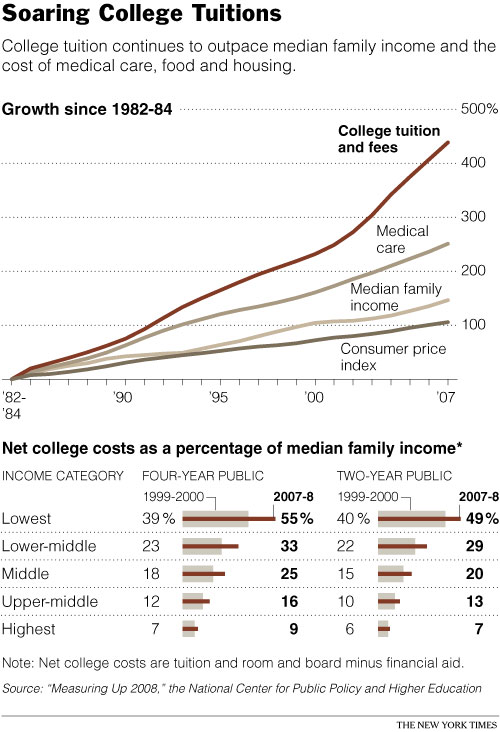 Imagine a market with incumbents whose core processes are unchanged since medieval times that is held together by huge federal subsidies and protected by a system of self-accreditation designed to exclude rivals. Imagine that the resulting enterprises exploited their monopoly power by overcharging customers and wasting the revenue that resulted on guaranteeing senior employees lifetime employment and discretionary funds, on massively expensive professional sports teams, and on protecting an overstaffed and comically inefficient bureaucracy worthy of the Indian railroads. Who would put up with such a mess?
Welcome to American colleges and universities, which are both the envy of the world and ripe for disruption. It's a big business (about $350 billion in the US alone) and a really soft target. It is, after all, run by tenured scholars whose idea of competition is a snarky jibe in the faculty lounge. The dons have allowed their costs to not only rise faster than family incomes, but faster than health care costs, which ain't easy. That they have lasted this long is due to the monopoly they enjoy on certifying talent. As Kevin Carey noted in a recent New Republic article,
Imagine a market with incumbents whose core processes are unchanged since medieval times that is held together by huge federal subsidies and protected by a system of self-accreditation designed to exclude rivals. Imagine that the resulting enterprises exploited their monopoly power by overcharging customers and wasting the revenue that resulted on guaranteeing senior employees lifetime employment and discretionary funds, on massively expensive professional sports teams, and on protecting an overstaffed and comically inefficient bureaucracy worthy of the Indian railroads. Who would put up with such a mess?
Welcome to American colleges and universities, which are both the envy of the world and ripe for disruption. It's a big business (about $350 billion in the US alone) and a really soft target. It is, after all, run by tenured scholars whose idea of competition is a snarky jibe in the faculty lounge. The dons have allowed their costs to not only rise faster than family incomes, but faster than health care costs, which ain't easy. That they have lasted this long is due to the monopoly they enjoy on certifying talent. As Kevin Carey noted in a recent New Republic article,
The historic stability of higher education is remarkable. As former University of California President Clark Kerr once observed, the 85 human institutions that have survived in recognizable form for the last 500 years include the Catholic Church, a few Swiss cantons, the Parliaments of Iceland and the Isle of Man, and about 70 universities. The occasional small liberal arts school goes under, and many public universities are suffering budget cuts, but as a rule, colleges are forever.Small wonder that thousands of startups are now focusing on the market for higher education. Even the guy who discovered disruption, Clayton Christensen, has declared that online technologies will thoroughly disrupt education at all levels, predicting that half of all K-12 classes will be taught online by 2019. During the past five years, online higher education has gone mainstream. The Sloan Foundation estimates that more 30% of all enrolled college students, some six million people, participated in on-line learning at accredited U.S. colleges and universities in 2011 and that the U.S. market for online higher education grew 12-14 percent annually between 2004-2009. Many educators are realizing that the explosion of online education not simply due to its lower cost; it is often higher quality as well. Sometimes this is because of dramatically higher investment in course and instructor development. Christensen notes that the largely online University of Phoenix spends about $200 million each year developing online teachers and highlights a key difference with traditional universities: "..Harvard defines research as creating new knowledge, while The University of Phoenix defines it as finding new ways to provide knowledge. It blows the socks off of us in their ability to teach so well." Online education is quickly killing the in-class lecture, since recorded lectures have obvious advantages. Students can watch them when they are ready -- after they are off work or when the kids are asleep. They can replay the confusing bits or skip the obvious parts. Most important however, is that the lectures themselves are more likely to delivered by world class teachers like Norman Nemrow, whose online accounting course has been taken by several hundred thousand students or by Walter Lewin, the MIT physicist whose lectures are shown on television. Supposedly over five million people have taken his intro to physics course (watch his promo reel below to see why. What? Your professor did not have a promo reel?) It is not only lectures that fare better online. Instructors in online classes can measure outcomes and tailor the course to the needs of each student. Modern learning management systems provide live seminars with multi-location live video, backchat, social media, and many other capabilities not available in a classroom. Quizzes can be graded instantly so that both faculty and students get feedback fast enough to change course. Algorithms distill questions from thousands of students so that they can be answered either live or off-line. Students can undertake projects online with "classmates" who have never been on the same campus -- or even the same country. This is a time of vast experimentation with online education technologies. Two years ago, the Kahn Academy began to attract huge notice as a self-tutoring tool based on the brief lectures of one talented teacher. A year ago, 2Tor closed a large Series C and got very serious about providing major universities with technology, marketing, and course development assistance. A month ago, Google's self-driving car maven Sebastian Thrun gave the talk at BLD in Munich that launched Udacity after 160,000 students from around the world completed his Stanford-based online computer science course (268 students achieved perfect scores on all the quizzes). In October, Knewton, an education technology startup, raised $33 million in its 4th round of funding to roll out its adaptive online learning platform. Earlier this year, Apple launched a suite of authoring and course scheduling tools to allow universities to move content to iTunes University. Only yesterday ShowMe launched its 2.0 platform that takes the Kahn Academy model and makes it social -- anyone can use the platform to teach anything. Universities are developing their own online education initiatives, often plagued by a terrifying thought: what if online education is just another form of digital media? They know full well that that as books, movies, and music, moved online, few incumbents survived. In each case:
- Content was disaggregated and mashed. Just as record albums were broken into songs, ringtones, and clips, educational content is unlikely to remain entirely within current disciplines or courses. Literature will not remain separated from history, nor calculus from chemistry. As technology makes it easier to recombine and repurpose courseware, it may become possible for two students to complete the same course without confronting the same content in the same sequence or manner. New forms of learning will produce certifications not limited to degrees, concentrations, or even courses.
- Engagement became social. Digital movies benefitted Hollywood much less than YouTube and Netflix. It should not surprise us to see more learning become self-paced, socially certified, and delivered outside of colleges and universities. Startups may increase the demand for formal education, but they could also substitute for it just as many of the needs once filled by campus fraternities or alumni associations are now met by online social networks.
- Value shifted from content creators to aggregators. Book publishers and music labels learned that aggregators of content (Amazon and iTunes) hold a lot of cards. Will universities aggregate and distribute high quality educational content regardless of its origin? Or will universities, like film studios, attempt to remain relevant by offering exclusive, premium-priced, high-quality, proprietary content protected through careful online distribution and syndication? Top universities are betting on the Hollywood model, which is not only under sustained attack, but presumes producers who control their IP. Universities, in contrast, rarely limit the ability of their faculty to sell lectures and other courseware to the highest bidder, even though the university paid the professor to produce the content. In no other industry is such theft conceivable -- a fact that Udacity will not be the last to exploit.
- The product went global. Books, movies, and music are licensed or sold in tightly controlled, nationally bounded markets, but digital media is naturally global because there are far fewer natural distribution barriers. This means more customers, which is why universities are now lusting after talented and wealthy Indian and Chinese students who are (at the moment anyway) willing to pay US-type tuition for a degree from a globally prestigious institution.
- Prices fell as comparison shopping became easier. It appears that the revenue optimal price for eBooks is between $2 and $5, depending on the author and in some cases the publisher. For songs it is between $1-$2, forcing record labels and publishers to seek entirely different business models to monetize their content. As a result, many of media markets actually shrank as they went online (if you only measure product sales. In music, for example, the market is about the same size, because concerts and merchandise make up for losses in record sales). Once
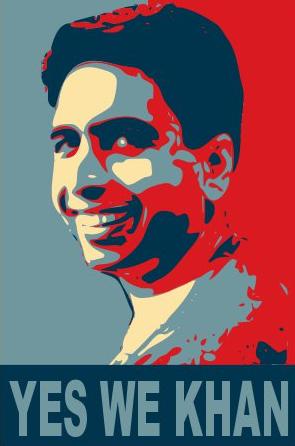 Barnes and Noble charges customers for a wide range of activities unrelated to book purchases. It designed many of its stores as community centers where authors and could meet readers. It built fun sections for kids to discover books. It integrated Starbucks in many locations. But books are simply not going to be sold in stores much longer, so these activities added more cost than value and ended up making the problem worse. Likewise, many institutions of higher education support multiple activities with tuition: research, sport, socialization, teaching, and credentialing. Online education exposes the fault lines between these different businesses, just as Amazon did with Barnes and Noble.
Barnes and Noble charges customers for a wide range of activities unrelated to book purchases. It designed many of its stores as community centers where authors and could meet readers. It built fun sections for kids to discover books. It integrated Starbucks in many locations. But books are simply not going to be sold in stores much longer, so these activities added more cost than value and ended up making the problem worse. Likewise, many institutions of higher education support multiple activities with tuition: research, sport, socialization, teaching, and credentialing. Online education exposes the fault lines between these different businesses, just as Amazon did with Barnes and Noble.
- Research. Top schools recruit faculty based on their ability to contribute new knowledge to their field not on their ability to teach. This is terrific for graduate students, who apprentice and occasionally indenture themselves to senior faculty, but suboptimal for undergraduates because the correlation between insightful research and capable undergraduate teaching is somewhere between weak and negative. Once undergraduates can receive a higher quality education at a lower cost by studying online, many will do so. Once Amazon made books cheaper, nobody wanted to pay for those kids play areas -- not even people who liked them.
- Sports. That giant sucking sound is money draining from university budgets to support massively wasteful professional sports programs -- while managing to abuse college athletes in the process. Intercollegiate sports are fine. Division 1 football and basketball is a scandal -- and both universities and the NCAA know it.
- Teaching. Teaching and learning are rapidly becoming another online interactive social media. Some online learning will doubtless be indistinguishable from games. This part of what a university does will be rapidly mashed, commodified, and redistributed, just as books and movies have been. Universities often claim that they make use of these online technologies in "hybrid" classrooms. This is like selling Nooks in bookstores: the customers who buy will never come back.
- Socialization. Residential undergraduate programs deliver to young people a group of peers and the experience of learning independently with them. Some of what the university provides is in loco parentis -- a structured environment for 18-22 year olds to transition to self-sufficiency as they learn. The question is how much families will pay for this service. As high quality online education becomes universally available, middle class families will be very tempted to forgo residential colleges for their kids. Now that families cannot enhance their incomes by working longer hours, sending a second adult to work, or borrowing easy money against overvalued homes, families will be willing to cut back on college expenses if it does not compromise the quality of their children's education.
- Credentialing. Credentials are necessary for employers and future education institutions to distinguish between similar candidates. Many markets with this problem rely on brands or other signaling effects (watch how you select wine next time you are confronted with dozens of plausible choices). University degrees emerged long ago as a critical signal of professional capability independent of what the degree holder knows. Part of this is because of selection effects, as Malcom Gladwell explained some years ago:
Social scientists distinguish between…treatment effects and selection effects. The Marine Corps, for instance, is largely a treatment-effect institution. It doesn’t have an enormous admissions office, grading applicants along four separate dimensions of toughness and intelligence. It’s confident that the experience of undergoing Marine Corps basic training will turn you into a formidable soldier. A modeling agency, by contrast, is a selection-effect institution. You don’t become beautiful by signing up with an agency. You get signed up by an agency because you’re beautiful.
Top-tier universities produce top graduates by accepting applicants who are very likely to succeed -- they trade heavily on selection effects. I once published a proposal in the campus newspaper challenging the Dean of the Harvard Business School to compare people who were admitted to HBS but did not attend with those who were admitted but did attend to see if the school was adding value or simply selecting people who were going to succeed anyway. He showed little enthusiasm for my research proposal, although other scholars (including Alan Krueger, who now chairs Obama's Council on Economic Advisors) have since documented these selection effects.
Treatment effects also create signals, whether anybody learns anything or not. Imagine that you have two job candidates who 25 years earlier attended the same school and took the same courses. One candidate failed every course and did not graduate. The other got straight As in the courses and graduated with honors, but has forgotten 100% of the material. Neither currently knows anything that they learned in college. But if this is all the information you had, you would hire the successful student -- you'd be crazy not to. You have a signal that this person is capable of hard work and learning, even if they don't retain it 25 years later. In labor markets, signaling matters a lot and university degrees are powerful signals. Online education will not quickly change this -- although the creation of alternative credentialing mechanisms may.
Who decides what signal a degree sends? Employers do. If Google or Goldman begin hiring software engineers or managers who received their professional degrees online, the value of elite professional degrees will come into question. As a future post will detail, this is very likely to happen, since the knowledge and skill imparted by most professional degree programs can more easily be standardized, sequenced, and captured on standardized tests than undergraduate education can. Universities are rushing to offer professional degrees online because because students are willing to pay high tuition to finance a degree that will significantly increase their earnings. If competition from online professional degree programs pressures schools to reduce either tuition or admissions requirements, universities will see their professional degree cash cow led to slaughter. For this reason, better known universities hope fervently that dozens of competing online degree programs to emerge, saturate the market, and preserve the signaling value of the premium degree they offer. As high quality education moves online, it will kill the weakest first: those schools that charge more and deliver less. Elite research universities will be forced to trade heavily on their brand and the signaling value of their credential, which may become easier as online programs proliferate and education markets become even more global. The experience of going to college may never be reducable to interactive social media -- but classroom teaching and learning surely is.Two Questions for California’s College Students
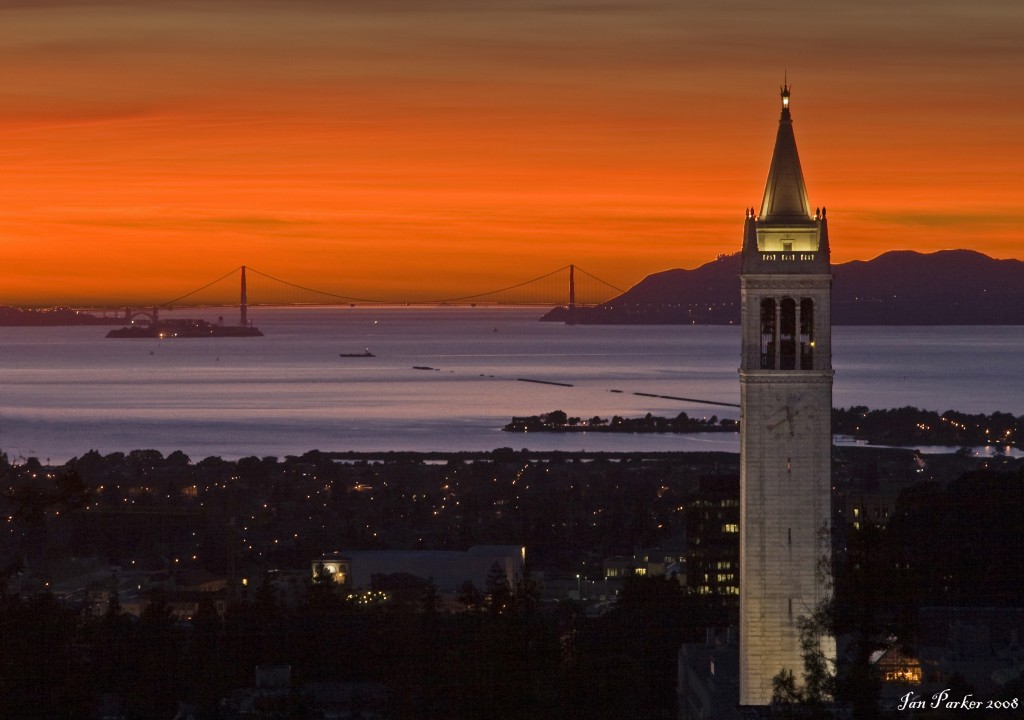 Perhaps the only thing more depressing than the sight of hundreds of students and faculty on a "99 Mile March" to defend California's system of higher education from budget cuts is the failure of the state legislature to vigorously defend the engine of the state's wealth and economic mobility. The protests now underway in Sacramento demonstrate why California's system of higher education is far too important to entrust to faculty, students, or legislators.
Any group wishing to challenge cuts in public spending that benefit them directly has a political problem if taxpayers see costs without benefits. So the group wishing to protect themselves from the cuts needs to answer two questions: Who else benefits from the spending? and How can we increase our public contributions? If the marchers trying to channel their inner Cesar Chavez had taken the first question seriously, they would have built a coalition. Had they been courageous in their answer to the second, they would have built a movement. Chavez, not incidentally, understood this and knew that those who ask only what their country can do for them produce the political equivalent of a large yawn.
Perhaps the only thing more depressing than the sight of hundreds of students and faculty on a "99 Mile March" to defend California's system of higher education from budget cuts is the failure of the state legislature to vigorously defend the engine of the state's wealth and economic mobility. The protests now underway in Sacramento demonstrate why California's system of higher education is far too important to entrust to faculty, students, or legislators.
Any group wishing to challenge cuts in public spending that benefit them directly has a political problem if taxpayers see costs without benefits. So the group wishing to protect themselves from the cuts needs to answer two questions: Who else benefits from the spending? and How can we increase our public contributions? If the marchers trying to channel their inner Cesar Chavez had taken the first question seriously, they would have built a coalition. Had they been courageous in their answer to the second, they would have built a movement. Chavez, not incidentally, understood this and knew that those who ask only what their country can do for them produce the political equivalent of a large yawn.
- The California Community Colleges is the largest higher education system in the nation. Its 112 colleges provide more than 2.9 million students with basic skills education, workforce training, preparation for four-year universities. They attract working student and ambitious immigrants in very large numbers. I used my local community college to learn blueprint reading and geometric dimensioning and tolerances to become a machinist; I also took classes in physics because they were exceptionally good. Almost 60% of CSU graduates and 30% of UC graduates originally transferred from a California community college.
- California State University has 23 campuses, some 427,000 students, and 44,000 faculty and staff. It is the largest, most diverse, and one of the most affordable university systems in the country. CSU graduates 44% of the life sciences college graduates California, more than 60% of all of the state’s teachers, including 9 out of 10 of California's public school educators, and 45% of the state’s computer and electronic engineers. CSU is an outstanding resource for underserved populations, awarding more than half of the bachelor degrees earned by African American, Latino, and Native American students in California.
- The University of California is a top-tier research university and an economic catalyst for the state. UC's ten campuses enroll more than 220,000 students and employ more than 170,000 faculty and staff. Its three national labs manage hundreds of millions of dollars of state and federal research. A recent study estimated that UC generates $46.3 billion in annual economic activity for California, not counting benefits such as technology startups that grow directly out of university research.
- A National Research Council analysis of U.S. universities concluded that UC Berkeley has the largest number of highly ranked graduate programs in the country. The analysis ranked doctoral programs within a range (such as between 1st and 5th), and found that 48 out of the 52 Berkeley programs assessed ranked within the top 10 nationally.
- Over the past decade (2000-2009), the National Science Foundation awarded more Graduate Research Fellowships to UC Berkeley students than to those of any other university (MIT was 2nd; Stanford 3rd; Harvard 4th).
- 135 Berkeley faculty are members of the prestigious National Academy of Sciences, exceeded only by Harvard with 150. 91 are members of the National Academy of Engineering, exceeded only by MIT with 105. Membership in the American Philosophical Society, the American Academy of Arts and Sciences, or winners of National Medal of Science teach overwhelmingly at three schools -- Berkeley, Harvard and Stanford. Only one of these is a public institution.
- Berkeley's single proudest claim however, ahead even of its 24 national rugby championships, is that it enrolls more students on Pell Grants than all of the Ivy League schools put together. A Pell Grant is a scholarship based on financial need. By serving academically qualified students on Pell Grants, Berkeley ensures that smart, hard-working kids from low income families can get a top-flight education.
Whatever Happened to the United Farmworkers?
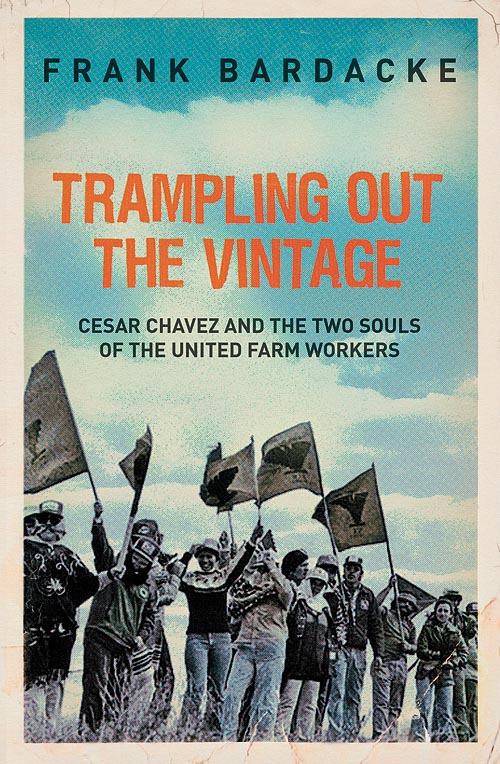 On New Year’s Day, a friend mentioned that Frank Bardacke had published his long-anticipated history of the rise and fall of Cesar Chavez and the United Farmworkers. It was worth the wait, he assured me and “completely stunning. Just get it and read it. You won’t put it down.”
He was right.
Bardacke, a respected labor activist and educator based in Watsonville California, was first mentioned in this blog six years ago in connection with his research on Cesar Chavez. Like Bill Gates and Mark Zuckerberg, he dropped out of Harvard after his freshman year and moved west to change the world. Unlike them, he joined the Berkeley Free Speech Movement and has had an abiding interest in radical politics ever since. In the early 70s, I traveled to China with Bardacke to get a first hand look at Mao’s proletarian dictatorship. Frank admired all things proletarian; I feared the dictators. Bardacke often views the world through a different template than I do, but I have learned a lot from him and continue to have enormous respect for his views.
Bardacke became a farmworker – one of a handful of Anglos and surely the only former Harvard student to work the celery fields. He became fluent in Spanish and formed friendships with many of the union staff and farmworkers who appear in his book. He spent more than a decade interviewing every major participant in the drama, reading every known book on the farmworkers and scouring every archive. He received help in managing this massive project from faculty in history and politics at nearby UC Santa Cruz.
The result, Trampling Out the Vintage: Cesar Chavez and the Two Souls of the United Farmworkers, is the most complete account yet of the rise and fall of the UFW. It is also an epic, Shakespearean drama with all of the elements of a Hollywood blockbuster. The pitch meeting would be surreal:
On New Year’s Day, a friend mentioned that Frank Bardacke had published his long-anticipated history of the rise and fall of Cesar Chavez and the United Farmworkers. It was worth the wait, he assured me and “completely stunning. Just get it and read it. You won’t put it down.”
He was right.
Bardacke, a respected labor activist and educator based in Watsonville California, was first mentioned in this blog six years ago in connection with his research on Cesar Chavez. Like Bill Gates and Mark Zuckerberg, he dropped out of Harvard after his freshman year and moved west to change the world. Unlike them, he joined the Berkeley Free Speech Movement and has had an abiding interest in radical politics ever since. In the early 70s, I traveled to China with Bardacke to get a first hand look at Mao’s proletarian dictatorship. Frank admired all things proletarian; I feared the dictators. Bardacke often views the world through a different template than I do, but I have learned a lot from him and continue to have enormous respect for his views.
Bardacke became a farmworker – one of a handful of Anglos and surely the only former Harvard student to work the celery fields. He became fluent in Spanish and formed friendships with many of the union staff and farmworkers who appear in his book. He spent more than a decade interviewing every major participant in the drama, reading every known book on the farmworkers and scouring every archive. He received help in managing this massive project from faculty in history and politics at nearby UC Santa Cruz.
The result, Trampling Out the Vintage: Cesar Chavez and the Two Souls of the United Farmworkers, is the most complete account yet of the rise and fall of the UFW. It is also an epic, Shakespearean drama with all of the elements of a Hollywood blockbuster. The pitch meeting would be surreal:
OK, picture this: we have a conservative Catholic who fasts and marches like he’s Ghandi. He courts progressive clerics and hires liberal Jews and alienated Anglos to mobilize immigrant Mexicans and Philipinos to fight Slavic and Italian growers. At first David slays Goliath, but then he morphs into King Lear and destroys his newly built kingdom amidst slaughter and recrimination. We’ve got side plot romances between devotees who work for $5/week and bad food trying to raise farmworker pay. We've got violent Teamster, UFW, and grower thugs straight out of the Sopranos. We've got a certifiably batshit human potential guru who wreaks havoc getting everyone to criticize everyone else. And under the carpet here somewhere, we may even have communists trying to advance a proletarian revolution without a proletariat. How can we miss?”Astonishingly, it is a true story and Bardacke delivers it with intelligence and compassion. Unique among labor historians, he grounds his analysis in “the work itself”, with brilliant, memorable descriptions of how different stages of production for different crops in different regions of California all affect the ability and willingness of different crews to self organize. He describes clearly why organizing was often sustained by the tight-knit, highly skilled lechugeuros or the celery cutters, not the garlic or asparagus workers or those in ladder crops. He describes the skill and endurance that the work requires, introduces leaders that arise from various crews, and captures in fine detail how they interact with a union that was built on a very different set of principles from farm work. In a decade spent organizing waiters, housekeepers, nurses, bartenders, machinists, cannery workers, and assembly workers, I observed precisely these differences. The work itself shapes our propensity to organize. Bardacke is the first writer to apply this principle to the fields and he does so with a deep understanding and compassion for the work. Bringing an existing union into a workplace is an act of industrial combat not for the faint of heart -- but starting a new union from scratch is a herculean task that almost always fails. I started a company that has lasted more than a decade, a public agency that lasted three years, and a union (United Espresso Workers – I was a bit early) that lasted all of three weeks. With the proud exception of the United Farmworkers, I cannot think of a single independent union formed in the United States in the past 50 years that was not sponsored and controlled by an incumbent union (I can think of several that tried and died – but none who made it). This was not always true -- new unions once spawned regularly in the US. There are many reasons for the change, but the lack of competition between unions has positioned them nicely for extinction. Organizations evolve through the mutation, variation, and selection that is always produced by competition. The labor movement stopped growing the instant the AFL joined with the CIO and prohibited unions from competing with each other. When two teachers unions competed, both grew. The instant the Teamsters stopped raiding the UFW, growth stopped. I hated the Teamsters (who were kicked out of the AFL-CIO for corruption and are not subject to the noncompete provisions) and I took a nasty beating from them once, but like sharks or wolves, they have their place in the ecosystem. (I am aware of no union leader who agrees with this view, by the way. Most feel that they have all the competition they can handle from employers). But for a brief moment following the civil rights movement in the 1960s, a new labor union arose in the United States and in the least likely place. If you had asked in 1960 where in the economy a new union might appear, you would never have selected the farmworkers of California. Organizers prefer workers who are tied to one place and to one employer, not workers who are seasonal and often itinerant. Probably wrongly, organizers prefer workers who are covered by labor laws, which had always exempted farmworkers. Organizers like English-speaking Americans, not Tagalog or Spanish-speaking immigrants or Braceros who are tolerated for a season then ushered back to Mexico. A dozen or so failed efforts by farmworkers to form agricultural unions seemed to validate Marx and Lenin’s belief that workers would organize once they were forced into factories and worked for a single employer. Bardacke demonstrates that Cesar Chavez succeeded in organizing farmworkers because he was, at heart, a brilliant and hard-working Alinksy-trained community organizer. As a community organizer, Chavez pioneered an enormous innovation that had the potential to transform labor organizing: he mastered the secondary boycott (illegal for most workers under the federal labor law, which thoughtfully excludes farmworkers). Chavez tirelessly organized enormous boycott operations in grapes, lettuce, and against major retailers including Safeway. Farmworker boycotts were the Occupy movement of the 70s and 80s – a way for college students, community activists, and middle class young people to participate directly in the tough work of social change. And credit Chavez's brilliant leadership, it worked magnificently: faced with effective boycotts, growers raised wages and improved working conditions and politicians begged the army of grass-roots Chavistas to help register voters and turn them out on election day. The UFW became a powerful force for social change. But the UFW was only briefly a powerful labor union. Bardacke correctly diagnoses the boycott as creating a formidable tension within the UFW. He frames the tension between labor and boycott organizing as a struggle between the "two souls" of the UFW. The metaphor is fraught. As Bardacke demonstrates, the UFW collapses not because it has two souls, but because none of its activities were organized, financed, or led in a manner that enable them to grow. The problem is not that community organizing is a distraction -- most American labor unions lack a community service organization and are much the weaker for it. This is tragic: having discovered and refined one of the few recent innovations in union organizing, Chavez cannot let it grow. Instead, he strangles his own child. One of the heros of Bardacke’s book is Marshall Ganz, one of America's most innovative labor organizers. Ganz also dropped out of Harvard, but moved south to organize for civil rights before heading west. After his exile from the UFW, Ganz helped the Silicon Valley Central Labor Council build a powerful neighborhood-based political organization for the 1984 elections. He was terrific at posing fundamental questions – and at directing me and others to writers and thinkers who helped answer them. In 1984 he urged me to read, of all things, a business book, In Search of Excellence. I quickly developed an appetite for business writing. decided to get trained in it, and ended up working with the book’s authors. Marshall returned to Harvard, got his degree after a 28 year hiatus, and now teaches at the Kennedy School. (His version of the UFW story, told in Why David Sometimes Wins, is a fine companion volume. It suffers for being his PhD dissertation and dwells more deeply on theories of organizing and less on the dynamics of local struggles). So let’s ask a Marshall Ganz-like question: what does it take for an organization to grow successfully? Venture capitalists, a group not deeply concerned with the welfare of those who produce their salads, obsess about this question. There are at least as many answers as there are VCs, but common elements include:
- A big market. If there is not substantial demand for the product or service an organization produces, the organization cannot get very big.
- Positive unit economics. If serving one more person imposes more cost on the organization than it generates in revenue, then growth makes no economic sense and the organization will depend for growth on funding from charity or government. Anyone can sell a dime for a nickel; selling a nickel for a dime means that an organization has to add at least a nickel’s worth of value if it wants to grow.
- Customer or member acquisition costs that scale. Every organization has a cost of acquiring a customer that must be repaid over the lifetime of that customer or member. Smart organizations exhibit declining COA: the cost of acquiring each incremental customer declines with scale. Very smart organizations (and effective social movements) are viral: COA approaches zero as current participants recruit new ones. See Facebook, Google, or Arab Spring.
- Leadership. Growth is very, very demanding on an organization. Everyone in a fast-growing organization has to grow with it: jobs change radically every few months. Not everyone grows at the same pace, so leaders must recruit furiously, communicate direction and values continually, promote and replace people regularly, and test what works all the time. It is stressful and a lot of fun – ask anyone who has been involved in a fast-growing company, boycott, strike, or organizing campaign.
Read the rest of this entry »
What Lives After: Remembering Five Who Died This Week
Shakespeare's immortal eulogy delivered by Mark Anthony for Julius Caesar resonates this week: “The evil that men do lives after them; The good is oft interred with their bones.” We lost five remarkable men from different parts of the world. Four of them made the planet an immeasurably better place. One devoted his life to evil that survives his death. George Whitman, 1913-2011 I have known hundreds of booksellers; the most memorable by far was George Whitman, proprietor of Shakespeare and Company, across from Notre Dame at point zero in Paris. His store, like its namesake run by Sylvia Beach during the 1930s, became point zero for two generations of writers and wanderers. I am one of tens of thousands of people who was taken in by George, absorbed into his literary world, made part of his little "Rag and Bone shop of the heart". George never cared about money, food, or finery -- he cared about people, literature, and travelers. He was especially drawn to young people, to whom his generosity was legendary.
I last saw George four years ago. My tribute to him at the time reads nicely today. I recalled my days living in Shakespeare in January of 1976, decades after Jackie Onassis had come through as a student and around the time that a young Greek immigrant named George Soros hung his hat at Shakespeare & Co. for several days.
The New York Times ran a wonderful obituary about George, who had written his own eulogy years earlier. Inscribed over a doorway that led to the upstairs of Shakespeare was a motto: "Be not inhospitable to strangers," it counseled, "for they may be angels in disguise". George did not, in fact, treat every visitor like an angel in disguise. But he gave visitors a place to discover their literary angels, and more than a few rose to the challenge.
Christopher Hitchens, 1949-2011
His store, like its namesake run by Sylvia Beach during the 1930s, became point zero for two generations of writers and wanderers. I am one of tens of thousands of people who was taken in by George, absorbed into his literary world, made part of his little "Rag and Bone shop of the heart". George never cared about money, food, or finery -- he cared about people, literature, and travelers. He was especially drawn to young people, to whom his generosity was legendary.
I last saw George four years ago. My tribute to him at the time reads nicely today. I recalled my days living in Shakespeare in January of 1976, decades after Jackie Onassis had come through as a student and around the time that a young Greek immigrant named George Soros hung his hat at Shakespeare & Co. for several days.
The New York Times ran a wonderful obituary about George, who had written his own eulogy years earlier. Inscribed over a doorway that led to the upstairs of Shakespeare was a motto: "Be not inhospitable to strangers," it counseled, "for they may be angels in disguise". George did not, in fact, treat every visitor like an angel in disguise. But he gave visitors a place to discover their literary angels, and more than a few rose to the challenge.
Christopher Hitchens, 1949-2011

andA life that partakes even a little of friendship, love, irony, humor, parenthood, literature, and music, and the chance to take part in battles for the liberation of others cannot be called ‘meaningless’ except if the person living it is also an existentialist and elects to call it so.”
Beware the irrational, however seductive. Shun the ‘transcendent’ and all who invite you to subordinate or annihilate yourself. Distrust compassion; prefer dignity for yourself and others. Don’t be afraid to be thought arrogant or selfish. Picture all experts as if they were mammals. Never be a spectator of unfairness or stupidity. Seek out argument and disputation for their own sake; the grave will supply plenty of time for silence. Suspect your own motives, and all excuses. Do not live for others any more than you would expect others to live for you.”
Hitchens was always provocative, occasionally irritating, and frequently funny. I will miss his voice enormously.
Vaclav Havel, 1936-2011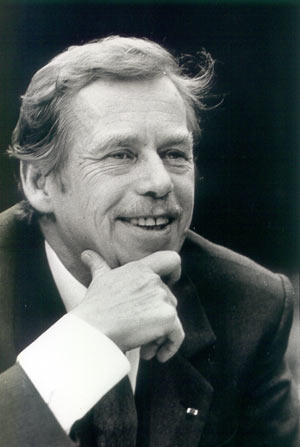 Imagine a political upheaval so profound as to be accurately called a revolution, so bloodless and smooth as to be called velvet, and so artistic that its leader was a playwright who conducted the insurrection from, and I am not making this up, the Magic Lantern Theatre, in Prague. Vaclav Havel is the Nelson Mandela of Eastern Europe, and his personal role as catalyst of the communist collapse his hard to overstate. From the Times:
Imagine a political upheaval so profound as to be accurately called a revolution, so bloodless and smooth as to be called velvet, and so artistic that its leader was a playwright who conducted the insurrection from, and I am not making this up, the Magic Lantern Theatre, in Prague. Vaclav Havel is the Nelson Mandela of Eastern Europe, and his personal role as catalyst of the communist collapse his hard to overstate. From the Times:
In 1977, Havel was one of three leading organizers of Charter 77, a group of 242 artists and activists who called for basic human rights in Czechoslovakia. Havel was arrested and imprisoned. He spent five years in and out of Communist prisons, lived for decades under daily police surveillance and suffered the suppression of his literary works.Later he served 14 years as president, resigning rather than see his country separated. He is author of 19 plays and dozens of essays, including "The Power of the Powerless", which influenced a generation of activists much as King's "Letter from a Birmingham Jail" had done in the United States. By the time he became President of Czechoslovakia, Havel had written more serious fiction than most heads of state had read. Timothy Garten Ash, then a British graduate student, witnessed the remarkable Havel in action during the Velvet Revolution. Havel's moral standing, his poetic use of language, and his patience made him as the dominant figure in resistance politics in Prague in 1989. Garten Ash reports in his indispensable first hand account of events that year in Prague, Budapest, and Berlin that Havel served as the chief behind-the-scenes negotiator who brought about the end of more than 40 years of Communist rule and the peaceful transfer of power. The revolt was so smooth that it took just weeks to complete and not a single shot was fired. Warren Hellman 1934-2011
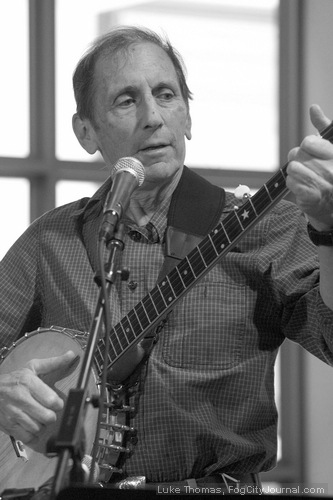 In business school, I became friends with Marco, the kid in the next seat everyone called Mick. I recall the day when a classmate told me "his father is Hurricane Hellman -- the youngest partner in the history of Lehman Brothers. He ran the place before he turned 40". Although I only met Warren Hellman a handful of times, I came to respect him as an icon of a group of prominent postwar Bay Area business Republicans who were deeply civic, secular Jews whose contribution to life in these parts is rarely noted. Architect Art Gensler and Gap Founder Don Fischer are others, as, excepting the Republican bit, are banker Bill Hambrecht and Levis heir Robert Haas.
If you live in the Bay Area, it is hard to overstate the impact of Warren Hellman. He saved San Francisco over a billion dollars by financing a ballot measure to reform the city's tottering pension system. He built the parking garage beneath teh DeYoung Museum in Golden Gate Park. He chaired the Board of Trustees at Mills College and reversed the decision to admit men (still a very popular decision, although I have argued a dubious one). He funded the San Francisco Free Clinic and endowed aquatic sports at UC Berkeley, where he had played water polo as a student. And in 2001, Hellman launched the Hardly Strictly Bluegrass festival, an annual three day event in Golden Gate park that draws more than 300,000 people and is put on for free. Hellman paid the musicians, usually including EmmyLou Harris and the late Hazel Dickens. Hellman himself was a serious amateur banjo player and toured with his group, the Wronglers, until quite recently.
Hellman was not only born into a remarkable family, but he created one as well. He was the great grandson of Isaias Hellman, California's first banker, who created what became Wells Fargo Bank and built the University of Southern California. His kids are high achievers who share his passion for athletics. Warren competed in extreme sports, once finishing a 100-mile high altitude race in the Sierra after falling and breaking a rib at mile 25. His kids have won championships in m mountain bike racing, skiing, and other sports.
Hellman was the sort of one percenter that the Bay Area loves: a guy who took much more pleasure from giving his money away than he did from making it; who walked away from Wall Street to build an investment firm as "the opposite of Lehman Brothers", who rarely wore a tie and never seemed to take himself terribly seriously, and who was disarmingly candid about his many failures. He has much to teach the pashas of Silicon Valley; I sincerely hope that they are up to the task.
Kim Jong Il, ??-2011
In business school, I became friends with Marco, the kid in the next seat everyone called Mick. I recall the day when a classmate told me "his father is Hurricane Hellman -- the youngest partner in the history of Lehman Brothers. He ran the place before he turned 40". Although I only met Warren Hellman a handful of times, I came to respect him as an icon of a group of prominent postwar Bay Area business Republicans who were deeply civic, secular Jews whose contribution to life in these parts is rarely noted. Architect Art Gensler and Gap Founder Don Fischer are others, as, excepting the Republican bit, are banker Bill Hambrecht and Levis heir Robert Haas.
If you live in the Bay Area, it is hard to overstate the impact of Warren Hellman. He saved San Francisco over a billion dollars by financing a ballot measure to reform the city's tottering pension system. He built the parking garage beneath teh DeYoung Museum in Golden Gate Park. He chaired the Board of Trustees at Mills College and reversed the decision to admit men (still a very popular decision, although I have argued a dubious one). He funded the San Francisco Free Clinic and endowed aquatic sports at UC Berkeley, where he had played water polo as a student. And in 2001, Hellman launched the Hardly Strictly Bluegrass festival, an annual three day event in Golden Gate park that draws more than 300,000 people and is put on for free. Hellman paid the musicians, usually including EmmyLou Harris and the late Hazel Dickens. Hellman himself was a serious amateur banjo player and toured with his group, the Wronglers, until quite recently.
Hellman was not only born into a remarkable family, but he created one as well. He was the great grandson of Isaias Hellman, California's first banker, who created what became Wells Fargo Bank and built the University of Southern California. His kids are high achievers who share his passion for athletics. Warren competed in extreme sports, once finishing a 100-mile high altitude race in the Sierra after falling and breaking a rib at mile 25. His kids have won championships in m mountain bike racing, skiing, and other sports.
Hellman was the sort of one percenter that the Bay Area loves: a guy who took much more pleasure from giving his money away than he did from making it; who walked away from Wall Street to build an investment firm as "the opposite of Lehman Brothers", who rarely wore a tie and never seemed to take himself terribly seriously, and who was disarmingly candid about his many failures. He has much to teach the pashas of Silicon Valley; I sincerely hope that they are up to the task.
Kim Jong Il, ??-2011
 Those looking for evidence that God has a sense of humor had a fine week. Not only did the Iraq war and the life of Christopher Hitchens end on the same day, but the loss of four of our finest was followed by the unmourned death of perhaps the worst human alive.
History will struggle to find a single kind word to say about Kim Jong Il. He built a hermetic garrison state, imprisoned and starved millions of his people, sponsored untold terrorist activities including the downing of a civilian airliner, and undertook military provocations and kidnappings against Japan and South Korea. He developed and tested thermonuclear weapons and sold them to some of the most unstable governments in the world, including Pakistan. He refined his doctrine of Juchu into a personality cult that represents the precise opposite of everything George Whitman, Christopher Hitchens, Vaclav Havel, or Warren Hellman stood for.
As Shakespeare predicted, the evil that Kim did will survive him. Kim's sudden death is problem for South Korea but an even larger problem for China. China has tended to treat North Korea as their pain-in-the-ass psychotic kid brother who refuses his meds but performs a useful service by keeping the neighbors on their guard. But an unstable North Korea is not a good thing for China. There is a strong argument that China will need to take over North Korea as a client state -- effectively a new province. In a generation or two, Korea would either unify in a Chinese economic sphere or the North would be forcibly absorbed, Tibet-like, into Han culture. It ain't Jeffersonian democracy, but it is hard to argue that this would be a worse outcome for the people of North Korea than the continued demented rule of the last standing communist dynasty.
Those looking for evidence that God has a sense of humor had a fine week. Not only did the Iraq war and the life of Christopher Hitchens end on the same day, but the loss of four of our finest was followed by the unmourned death of perhaps the worst human alive.
History will struggle to find a single kind word to say about Kim Jong Il. He built a hermetic garrison state, imprisoned and starved millions of his people, sponsored untold terrorist activities including the downing of a civilian airliner, and undertook military provocations and kidnappings against Japan and South Korea. He developed and tested thermonuclear weapons and sold them to some of the most unstable governments in the world, including Pakistan. He refined his doctrine of Juchu into a personality cult that represents the precise opposite of everything George Whitman, Christopher Hitchens, Vaclav Havel, or Warren Hellman stood for.
As Shakespeare predicted, the evil that Kim did will survive him. Kim's sudden death is problem for South Korea but an even larger problem for China. China has tended to treat North Korea as their pain-in-the-ass psychotic kid brother who refuses his meds but performs a useful service by keeping the neighbors on their guard. But an unstable North Korea is not a good thing for China. There is a strong argument that China will need to take over North Korea as a client state -- effectively a new province. In a generation or two, Korea would either unify in a Chinese economic sphere or the North would be forcibly absorbed, Tibet-like, into Han culture. It ain't Jeffersonian democracy, but it is hard to argue that this would be a worse outcome for the people of North Korea than the continued demented rule of the last standing communist dynasty.
Protection That Makes You Weaker
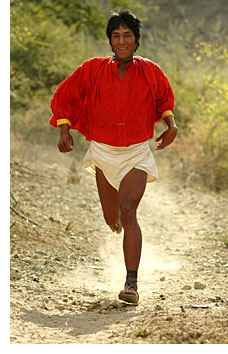 I have taken up running and, like boomers everywhere, I worry about hurting myself. Data suggest that between a third and half of runners get hurt running every year, making running a surprisingly high risk exercise. Why is this?
Journalist Chris McDougall wondered why he was getting hurt when humans have been running for two million years. His best-selling book, Born to Run, is a well-told tale of people who run barefoot without getting hurt and of researchers who discover a paradox: support can make you weaker, not stronger. The more support a running shoe gives you, the more it weakens your foot, ankle, and calf muscles and the more prone you become to injury.
McDougall presents the stories that led to the science and the science that has led to a resurgence of barefoot or minimal shoe running. He visits the Tarahumara, an impoverished clan of long distance runners living in the very remote Copper Canyons of Mexico. McDougall romanticizes their lives, describing men and women of all ages routinely running for dozens of miles in sandals over hot, steep mountains.
Scientists have studied the Tarahumara for years because their isolation makes them good subjects. As roads arrive, the Tarahumara embrace modernity: their diet goes from corn meal and long runs to pickup trucks and Hohos. Epidemiologists have documented the diabetes, cancer, and heart disease that result. McDougall looks past this, focusing instead on the propensity of the canyon-dwelling Tarahumara and some of their more crazed gringo brethren to race ridiculous distances wearing heuraches cut from old tires.
Back home, McDougall consults a Stanford track coach who refuses to let his athletes wear expensive running shoes and discovers data suggesting that both the extent and severity of injuries go up with the price of shoes. He interviews Daniel Lieberman, a Harvard biomechanics professor, who explains precisely how the support a of a running shoe makes most runners over stride and heel strike, which delivers a much sharper blow than a barefoot runner who lands mid foot. A good video of Lieberman explaining his research is below. The peer reviewed work is here in Nature.
Lots of testing and learning is still being done both by individuals and by researchers, but nobody these days takes for granted that running shoes are always helpful. Shoe companies are trying to shift their designs and their message to promote "minimalist" shoes, some of which are now best-sellers.
Is this just a fad? Of course any shoe can become a fad if well marketed. On the other hand, humans have run barefoot for two million years but have worn running shoes for only about 30. I would not bet against barefoot running, given the injury rates that shod runners experience.
Protection turns out to be deceptive. It seems completely normal to me that as a runner, I would prefer a protective shoe. I want lots of cushioning. I want to avoid pronation, which must be awful because it sounds so bad. It would be simple to sell me orthotics -- hey, my knees hurt sometimes. Although some people surely do fine in running shoes, for many people, highly protective shoes are like a cast. They reduce your mobility and your foot gets continually weaker as a result.
Economists, of course, know that protection often makes competitors weaker. They believe instinctively that competition strengthens counterparties, be they muscles, individuals, teams, companies, or regions. I have even argued that those who want stronger labor unions need to force unions to compete. Economists left and right can show that trade protection weakens both parties, although this knowledge never stops companies, communities, or workers who are hurt by trade from seeking it. Doubtless some similar principal applies to parenting: too much protection weakens your kids. Fine, now buckle your damned seat belt.
To evaluate social programs or parenting, we need the equivalent of the Tarahumara -- a group isolated from extraneous influences that can test whether social protections produce more benefits than costs. Fortunately, an impressive young economist has shown that many of our protective programs are testable. Esther Duflo is an MIT professor, a MacArthur genius grant winner, and the winner of the 2010 John Bates Clark Medal for the best economist under the age of forty. Watch her fascinating TED talk on how she tests programs to fight malaria, educate kids, and immunize children. This is barefoot economics at its best.
Testing of this sort requires an appetite for failure. Politicians, business people, and scientists each approach tests differently, depending on how failure affects them.
I have taken up running and, like boomers everywhere, I worry about hurting myself. Data suggest that between a third and half of runners get hurt running every year, making running a surprisingly high risk exercise. Why is this?
Journalist Chris McDougall wondered why he was getting hurt when humans have been running for two million years. His best-selling book, Born to Run, is a well-told tale of people who run barefoot without getting hurt and of researchers who discover a paradox: support can make you weaker, not stronger. The more support a running shoe gives you, the more it weakens your foot, ankle, and calf muscles and the more prone you become to injury.
McDougall presents the stories that led to the science and the science that has led to a resurgence of barefoot or minimal shoe running. He visits the Tarahumara, an impoverished clan of long distance runners living in the very remote Copper Canyons of Mexico. McDougall romanticizes their lives, describing men and women of all ages routinely running for dozens of miles in sandals over hot, steep mountains.
Scientists have studied the Tarahumara for years because their isolation makes them good subjects. As roads arrive, the Tarahumara embrace modernity: their diet goes from corn meal and long runs to pickup trucks and Hohos. Epidemiologists have documented the diabetes, cancer, and heart disease that result. McDougall looks past this, focusing instead on the propensity of the canyon-dwelling Tarahumara and some of their more crazed gringo brethren to race ridiculous distances wearing heuraches cut from old tires.
Back home, McDougall consults a Stanford track coach who refuses to let his athletes wear expensive running shoes and discovers data suggesting that both the extent and severity of injuries go up with the price of shoes. He interviews Daniel Lieberman, a Harvard biomechanics professor, who explains precisely how the support a of a running shoe makes most runners over stride and heel strike, which delivers a much sharper blow than a barefoot runner who lands mid foot. A good video of Lieberman explaining his research is below. The peer reviewed work is here in Nature.
Lots of testing and learning is still being done both by individuals and by researchers, but nobody these days takes for granted that running shoes are always helpful. Shoe companies are trying to shift their designs and their message to promote "minimalist" shoes, some of which are now best-sellers.
Is this just a fad? Of course any shoe can become a fad if well marketed. On the other hand, humans have run barefoot for two million years but have worn running shoes for only about 30. I would not bet against barefoot running, given the injury rates that shod runners experience.
Protection turns out to be deceptive. It seems completely normal to me that as a runner, I would prefer a protective shoe. I want lots of cushioning. I want to avoid pronation, which must be awful because it sounds so bad. It would be simple to sell me orthotics -- hey, my knees hurt sometimes. Although some people surely do fine in running shoes, for many people, highly protective shoes are like a cast. They reduce your mobility and your foot gets continually weaker as a result.
Economists, of course, know that protection often makes competitors weaker. They believe instinctively that competition strengthens counterparties, be they muscles, individuals, teams, companies, or regions. I have even argued that those who want stronger labor unions need to force unions to compete. Economists left and right can show that trade protection weakens both parties, although this knowledge never stops companies, communities, or workers who are hurt by trade from seeking it. Doubtless some similar principal applies to parenting: too much protection weakens your kids. Fine, now buckle your damned seat belt.
To evaluate social programs or parenting, we need the equivalent of the Tarahumara -- a group isolated from extraneous influences that can test whether social protections produce more benefits than costs. Fortunately, an impressive young economist has shown that many of our protective programs are testable. Esther Duflo is an MIT professor, a MacArthur genius grant winner, and the winner of the 2010 John Bates Clark Medal for the best economist under the age of forty. Watch her fascinating TED talk on how she tests programs to fight malaria, educate kids, and immunize children. This is barefoot economics at its best.
Testing of this sort requires an appetite for failure. Politicians, business people, and scientists each approach tests differently, depending on how failure affects them.
- Politicians pay a huge price for failure. This forces them to simplify problems and promise sound bite solutions. If they do not do this, they won't be elected and they won't be politicians. Politicians cannot say "wow, this is a tough problem. Let's try a bunch of things, fail at most of them, and learn what works." Most politicians suffer from what Tim Hartford calls the "God Complex". Hartford writes the Undercover Economist column for the Financial Times. He has published a terrific book called Adapt: Why Success Always Starts with Failure. You can get a flavor of his thinking at his fantastic TED talk. The God Complex is the equivalent of intelligent design: certainty that complex systems can best be managed centrally and that complex questions can be answered without the painful process of trial and error. Parents, CEOs, physicians, gods, and anyone else who pays a high price for failure are especially vulnerable.
- Business people embrace trial and error mainly because markets force them to. Hartford notes that ten percent of all businesses fail every year. A market economy can be looked at as a huge, ongoing experiment that evolves, like every complex system, because of variation and selection. The best leaders of complex systems acknowledge that leading edge problems don't have obvious solutions and encourage a structured process of trial and error. Hartford's book discusses the value of lots of small, low cost trials that are decoupled so that they don't spill over and of carefully documenting and interpreting results. An important and highly recommended read.
- Scientists love failure. It's how they learn. They understand that humans have evolved as complex systems through millions of years of variation and selection. They reason either deductively from data or inductively to ask have we evolved to run? Evolutionary biologists have long noted that the unique way we sweat for thermoregulation, our hairlessness, our odd bipedal design (more energy efficient than any quadruped), our unusual ability to breath multiple times per step, and our highly engineered feet, ankles, and hips all suggest anatomy designed to run.
Three Dimensional Science
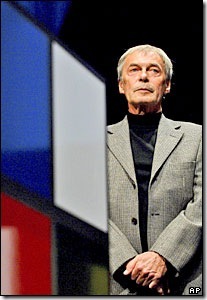 The World Science Forum currently underway in Budapest is a summit of academics who have traded their lab coats for leadership positions atop public and private agencies that promote and fund scientific research. These are fine people who support some of the best work in the world -- balancing real, complex science with often Byzantine organizational and national politics to advance the intellectual work that drives our world forward. To an outsider (that would be me), they are also convivially self-parodying academic Eurocrats and lobbyists who could have walked off the pages of a David Lodge novel.
The United States maintains posh embassies around the world to host worthies from events such as these and our current ambassador to Hungary did not disappoint. Obama's emissary is Eleni Tsakopoulous Kounalakis, Berkeley grad but Stanford donor, daughter of a real estate tycoon and a California-based Democratic activist of the Phil Angelides school of progressive realtors. She raised more than a million bucks for Hillary, which made her ambassador material. Budapest isn't bad duty (one can imagine her politely passing on an opportunity to serve in Athens, the family homeland).
She was a fine hostess and thoughtfully included entrepreneurs from interesting Hungarian startups including Prezi, UStream, Logmein, and NNG (formerly iGo). But the highlight of the reception and dinner hosted at the embassy came when Koualakis tapped my shoulder to introduce a short, shy, graying fellow "I'd like you to meet Erno Rubik". I fought back the urge to bow, shook his hand, and realized that he, like many others in the room, would rather be working.
Rubik is, of course, the inventor of the world's most popular toy -- the maddening twistable puzzle instantly understood by any child and rarely solved even by accomplished adults. It has spawned an industry of competitions, including speed-cubing, foot cubing (current world record for solving a Rubik's cube using only your feet is a bit over a minute), and blindfold cubing (look at the scrambled cube, get blindfolded, and work from memory. Good luck with that.)
We were all challenged to complete a scrambled cube (yeah, I know. There is an app for that. You photograph the cube and it shows you how to solve it. Erno even earns royalties on every download. But for once, I resisted). Personally, I always thought that the real innovation behind the cube was the weird bit of plastic in the middle that can be twisted every which way without breaking. And yes, I have taken a cube apart to see it, although I admit that there was a hammer involved. (If you want to try it, just twist the top 45 degrees and you can pop the thing apart pretty easily. Of course, you can reassemble it solved -- that's how many people do it).
Naturally neither America's top scientists nor Hungary's top entrepreneurs, people who solve three dimensional problems in their sleep, could restore a scrambled cube, which got me to wondering: which came first, the mathematics of the cube, or the puzzle itself? Surely a brilliant Hungarian mathematician like Rubik had computed the various solutions to a cube. Perhaps he had even tried to solve the "God number" question: what is the fewest number of moves that will restore any cube? The God number turns out to be 20 for a 3*3 cube, and a lot of mathematics together with 35 years of Google-donated CPU time went into figuring that out. Turns out however, that Rubik is an architect and game designer, not a mathematician.
There are of course, people who make solving Rubik's cubes look incredibly easy. For example, the world's record for solving a cube is....you won't believe it. So watch -- but don't blink or you'll miss it.
The World Science Forum currently underway in Budapest is a summit of academics who have traded their lab coats for leadership positions atop public and private agencies that promote and fund scientific research. These are fine people who support some of the best work in the world -- balancing real, complex science with often Byzantine organizational and national politics to advance the intellectual work that drives our world forward. To an outsider (that would be me), they are also convivially self-parodying academic Eurocrats and lobbyists who could have walked off the pages of a David Lodge novel.
The United States maintains posh embassies around the world to host worthies from events such as these and our current ambassador to Hungary did not disappoint. Obama's emissary is Eleni Tsakopoulous Kounalakis, Berkeley grad but Stanford donor, daughter of a real estate tycoon and a California-based Democratic activist of the Phil Angelides school of progressive realtors. She raised more than a million bucks for Hillary, which made her ambassador material. Budapest isn't bad duty (one can imagine her politely passing on an opportunity to serve in Athens, the family homeland).
She was a fine hostess and thoughtfully included entrepreneurs from interesting Hungarian startups including Prezi, UStream, Logmein, and NNG (formerly iGo). But the highlight of the reception and dinner hosted at the embassy came when Koualakis tapped my shoulder to introduce a short, shy, graying fellow "I'd like you to meet Erno Rubik". I fought back the urge to bow, shook his hand, and realized that he, like many others in the room, would rather be working.
Rubik is, of course, the inventor of the world's most popular toy -- the maddening twistable puzzle instantly understood by any child and rarely solved even by accomplished adults. It has spawned an industry of competitions, including speed-cubing, foot cubing (current world record for solving a Rubik's cube using only your feet is a bit over a minute), and blindfold cubing (look at the scrambled cube, get blindfolded, and work from memory. Good luck with that.)
We were all challenged to complete a scrambled cube (yeah, I know. There is an app for that. You photograph the cube and it shows you how to solve it. Erno even earns royalties on every download. But for once, I resisted). Personally, I always thought that the real innovation behind the cube was the weird bit of plastic in the middle that can be twisted every which way without breaking. And yes, I have taken a cube apart to see it, although I admit that there was a hammer involved. (If you want to try it, just twist the top 45 degrees and you can pop the thing apart pretty easily. Of course, you can reassemble it solved -- that's how many people do it).
Naturally neither America's top scientists nor Hungary's top entrepreneurs, people who solve three dimensional problems in their sleep, could restore a scrambled cube, which got me to wondering: which came first, the mathematics of the cube, or the puzzle itself? Surely a brilliant Hungarian mathematician like Rubik had computed the various solutions to a cube. Perhaps he had even tried to solve the "God number" question: what is the fewest number of moves that will restore any cube? The God number turns out to be 20 for a 3*3 cube, and a lot of mathematics together with 35 years of Google-donated CPU time went into figuring that out. Turns out however, that Rubik is an architect and game designer, not a mathematician.
There are of course, people who make solving Rubik's cubes look incredibly easy. For example, the world's record for solving a cube is....you won't believe it. So watch -- but don't blink or you'll miss it.
Hang 30: Time Surfing
Been awhile since we showed first rate surfing videos. This one from Aussie Rip Curl, uses a “30 camera array” and six world class surfers to enable editors to shift perspective, freeze frame from a combination of angles, and create the “Matrix” like illusion of perspective. Pretty cool.
They also produced a video on how they produced the video. Worth a look.
Seven Forces that Doom Bookstores and Publishers
 During the past few years, the music industry has been hammered. As music went digital, it was pirated, deconstructed, and mashed. As music stores and labels disappeared, their lobby, the RIAA, screamed bloody murder.
But amidst the carnage, a funny thing happened: the music industry grew larger even though it had fewer labels and far fewer retailers. Revenue from CDs was replaced by revenue from live concerts, ring tones, downloaded singles, merchandise, and sponsorships. The new industry has its challenges (many of them traceable to lousy music), but it has hardly collapsed.
This transformation presages the coming destruction of traditional book publishing and retailing, even as their overall publishing industry grows. Here are the seven reasons that bookstores and traditional book publishers are doomed.
7. Americans have stopped reading books. This is a non-trivial problem (after all, we did not stop listening to music). But the landmark National Endowment for the Arts study "Reading at Risk" confirms what we intuitively know: Americans read less than we used to. 43% of Americans read no books outside of work or school -- a number meaningfully lower than Canada or most European countries.
Those who do read books, don't read many of them. About 24 percent of Americans read eight or more books in 2002, a lower percentage of “strong readers” than two thirds of European countries surveyed. Only 16% of the US population reads a book or more each month. According to Morgan Stanley, 20% of all book buyers purchase a majority of all books. Men read much less than women. NPR reports that among active readers, women typically read nine books in a year, compared with only five for men. Women read more than men in all categories except for history and biography.
When most of us read, we prefer magazines and online articles that are shorter and less demanding than books. Kind of like you are doing right now.
During the past few years, the music industry has been hammered. As music went digital, it was pirated, deconstructed, and mashed. As music stores and labels disappeared, their lobby, the RIAA, screamed bloody murder.
But amidst the carnage, a funny thing happened: the music industry grew larger even though it had fewer labels and far fewer retailers. Revenue from CDs was replaced by revenue from live concerts, ring tones, downloaded singles, merchandise, and sponsorships. The new industry has its challenges (many of them traceable to lousy music), but it has hardly collapsed.
This transformation presages the coming destruction of traditional book publishing and retailing, even as their overall publishing industry grows. Here are the seven reasons that bookstores and traditional book publishers are doomed.
7. Americans have stopped reading books. This is a non-trivial problem (after all, we did not stop listening to music). But the landmark National Endowment for the Arts study "Reading at Risk" confirms what we intuitively know: Americans read less than we used to. 43% of Americans read no books outside of work or school -- a number meaningfully lower than Canada or most European countries.
Those who do read books, don't read many of them. About 24 percent of Americans read eight or more books in 2002, a lower percentage of “strong readers” than two thirds of European countries surveyed. Only 16% of the US population reads a book or more each month. According to Morgan Stanley, 20% of all book buyers purchase a majority of all books. Men read much less than women. NPR reports that among active readers, women typically read nine books in a year, compared with only five for men. Women read more than men in all categories except for history and biography.
When most of us read, we prefer magazines and online articles that are shorter and less demanding than books. Kind of like you are doing right now.
 6. Many of the books we read are crap. The largest single book category is still romance novels -- a fact so embarrassing to the New York Times and other tastemakers that they exclude the category entirely from best seller lists. These bodice-rippers, together with religion, self-help, fantasy, and thrillers, account for a majority of books sold in the US (Gothic romance, which did not exist before 1972, by itself accounts for a majority of all paperback sales). Nearly all of these sales are to women, but women buy and read a lot more books than men even if you adjust out the Harlequins.
Part of this is, no doubt, that brains exposed to constant media are not well wired for long form reading. We prefer writing that is built around tidy lists...oops. Nice essay to this effect by Alan Jacobs (hey, if you have read this far, you can manage it).
5. We can easily get books for free. Just Google "Torrent" and "Books" along with anything else and you will be directed to many sites that enable you to download books as pdf files easily readable on a tablet or an eReader. The site I checked helps you steal any of several dozen books on religion, most of which presumably counsel the reader against theft.
It is always hard to estimate the economic impact of illicit downloading. I wonder if the net effect isn't positive, even if authors howl. WordPerfect marketer Pete Peterson had a sensible point when he said that "if someone is going to steal software, I hope they steal ours". Every illegal download is not a lost sale -- but every time a reader finishes a book and raves about it, the marketing leads to new sales. Realizing this, most publishers will let you read the first chapter for free anyway. If we see publishers offering books for free but with advertising, we will know that the torrent sites have struck a nerve.
My current bet is that it won't happen for the same reason that iTunes curbed illegal music downloading. Customers like the ancillary content and the reliable file quality enough that if the experience is frictionless and the price sensible, we will pay.
4. "Books" are mutating. Like music and movies, books are becoming a service, not a product. Today Amazon launched its Kindle Lending Library, which turns books into a service like Spotify for music or Netflix for movies. The number of publishers who have embraced this idea? Zero. These guys would rather face the Torrent sites than let Amazon loan their books. But publishers need to monetize their back list. Over time, they will do a deal with Amazon, even if they require Amazon to purchase a new copy after a finite number of rentals. Many publishers require libraries to do that now -- and would doubtless oppose libraries as socialist if Ben Franklin hadn't established libraries before they got organized.
6. Many of the books we read are crap. The largest single book category is still romance novels -- a fact so embarrassing to the New York Times and other tastemakers that they exclude the category entirely from best seller lists. These bodice-rippers, together with religion, self-help, fantasy, and thrillers, account for a majority of books sold in the US (Gothic romance, which did not exist before 1972, by itself accounts for a majority of all paperback sales). Nearly all of these sales are to women, but women buy and read a lot more books than men even if you adjust out the Harlequins.
Part of this is, no doubt, that brains exposed to constant media are not well wired for long form reading. We prefer writing that is built around tidy lists...oops. Nice essay to this effect by Alan Jacobs (hey, if you have read this far, you can manage it).
5. We can easily get books for free. Just Google "Torrent" and "Books" along with anything else and you will be directed to many sites that enable you to download books as pdf files easily readable on a tablet or an eReader. The site I checked helps you steal any of several dozen books on religion, most of which presumably counsel the reader against theft.
It is always hard to estimate the economic impact of illicit downloading. I wonder if the net effect isn't positive, even if authors howl. WordPerfect marketer Pete Peterson had a sensible point when he said that "if someone is going to steal software, I hope they steal ours". Every illegal download is not a lost sale -- but every time a reader finishes a book and raves about it, the marketing leads to new sales. Realizing this, most publishers will let you read the first chapter for free anyway. If we see publishers offering books for free but with advertising, we will know that the torrent sites have struck a nerve.
My current bet is that it won't happen for the same reason that iTunes curbed illegal music downloading. Customers like the ancillary content and the reliable file quality enough that if the experience is frictionless and the price sensible, we will pay.
4. "Books" are mutating. Like music and movies, books are becoming a service, not a product. Today Amazon launched its Kindle Lending Library, which turns books into a service like Spotify for music or Netflix for movies. The number of publishers who have embraced this idea? Zero. These guys would rather face the Torrent sites than let Amazon loan their books. But publishers need to monetize their back list. Over time, they will do a deal with Amazon, even if they require Amazon to purchase a new copy after a finite number of rentals. Many publishers require libraries to do that now -- and would doubtless oppose libraries as socialist if Ben Franklin hadn't established libraries before they got organized.
Read the rest of this entry »
One more thing: Real artists ship.
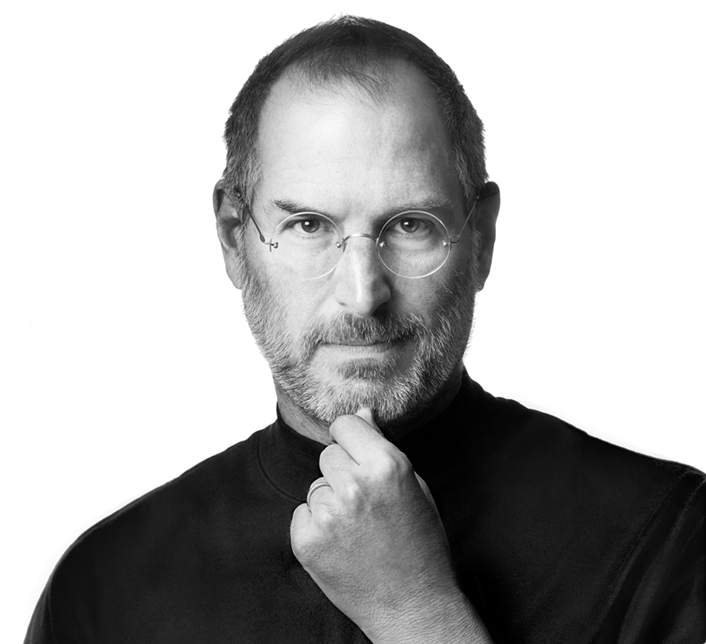 In preparation for landing at SFO, I had closed the MacBook Air and turned off the iPad, but as I touched down, my iPhone beeped. The text from my son made my heart sink: Steve Jobs died
In preparation for landing at SFO, I had closed the MacBook Air and turned off the iPad, but as I touched down, my iPhone beeped. The text from my son made my heart sink: Steve Jobs died  . At least three people left the plane in tears.
I felt like someone had unplugged my compass. Steve Jobs was by any reasonable measure the greatest entrepreneur and the greatest CEO in American history. He was a hero to his customers, but to most technology entrepreneurs, he was a God. He revered the Beatles and always reminded me of John Lennon: a genius with round glasses, a rebel with a mischievous grin, and an artist who showed the world things that it had not realized it wanted. With both, it takes years to absorb the full loss.
Steve Jobs had the soul of an an artist. Like Leonardo DaVinci, Samuel B. Morse, or Edwin Land, he lived at the intersection of humanities and technology and could ruthlessly carve away marble until only his vision of beauty remained. He was a practical poet who understood that "real artists ship". He accomplished his goal of "making a dent in the universe" -- but his premature death has left a dent in the hearts of people the world over.
Steve was the rarest of creatures: a business revolutionary motivated by a deep love of technology and its power to change the rules. We always knew that his "Think Different" ad was really about him:
. At least three people left the plane in tears.
I felt like someone had unplugged my compass. Steve Jobs was by any reasonable measure the greatest entrepreneur and the greatest CEO in American history. He was a hero to his customers, but to most technology entrepreneurs, he was a God. He revered the Beatles and always reminded me of John Lennon: a genius with round glasses, a rebel with a mischievous grin, and an artist who showed the world things that it had not realized it wanted. With both, it takes years to absorb the full loss.
Steve Jobs had the soul of an an artist. Like Leonardo DaVinci, Samuel B. Morse, or Edwin Land, he lived at the intersection of humanities and technology and could ruthlessly carve away marble until only his vision of beauty remained. He was a practical poet who understood that "real artists ship". He accomplished his goal of "making a dent in the universe" -- but his premature death has left a dent in the hearts of people the world over.
Steve was the rarest of creatures: a business revolutionary motivated by a deep love of technology and its power to change the rules. We always knew that his "Think Different" ad was really about him:
Here’s to the crazy ones. The misfits. The rebels. The troublemakers. The round pegs in the square holes. The ones who see things differently. They’re not fond of rules. And they have no respect for the status quo. You can quote them, disagree with them, glorify or vilify them. About the only thing you can’t do is ignore them. Because they change things. They push the human race forward. While some may see them as the crazy ones, we see genius. Because the people who are crazy enough to think they can change the world, are the ones who do.
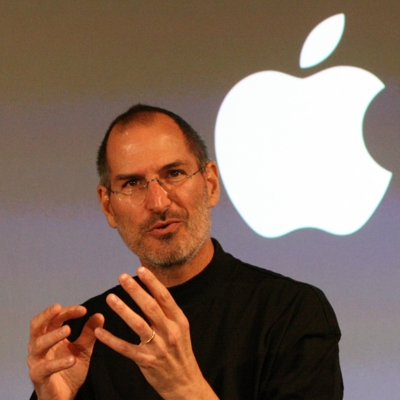 Steve broke rules eagerly. He dropped out of college and dropped acid. He fathered a daughter and disclaimed her, much as his Syrian biological father had lost track of him. He followed very odd diets and lived on communes. At age 20, he made a sojourn to India to see a guru. He learned to focus and focus some more. Often, this meant removing features. The original Mac had no cursor keys. Steve was the first to take away keyboards, mice, modems, floppies, Flash, screens, and CD-ROMs. Reviewers raged and the digerati derided him, but Steve knew that "innovation means saying no to a thousand things".
His passion often made him obnoxious. Seated next to him on a flight in 1979, he learned that I had made my Apple II usable for word processing by inserting a Z-80 card so that I could run WordStar under the CP/M operating system. He was appalled: "Why on earth would you ever do that?" he asked twice, shaking his long hair and making it very clear that I had flunked the bozo test. He publicly insulted competitors and employees. He launched huge products, including the iPad, with no market research ("it is not the consumer's job to know what they want".) At a dinner in 2006, he repeatedly assured me and others that Apple would never sell a telephone under any circumstances. Nobody believed him for a moment (six months later, he unveiled the iPhone), but any other CEO would have deflected the rumor instead of lying outright. This sort of behavior famously got him fired from his own company.
I harped constantly in this blog and elsewhere on his insistence that he control every aspect of the user experience. I recall construction workers building Pixar across the street from my company shaking their heads in awe every time Jobs would land on the property in his baby blue helicopter and take a pencil to their blueprints. He spent millions moving walls and even foundations at the last minute so they would end up precisely where he thought they should go. He obsessed about details that few CEOs notice (when you upgrade your iPhone next week, notice that as you bring the message shade to a full close, a very tiny animation rounds off the squared edges. Nobody but Steve Jobs would bother to do that.)
Steve Jobs failed. A lot. The Apple III was a disaster. The Lisa sold so poorly that tens of thousands of computers named after his daughter ended up in a large land fill in Utah. You have hardly heard of the Pippin, the Newton, the Copeland, HiFi, the G4 cube, Mobile Me, and several other products that were complete busts. It didn't matter. Jobs remained unbelievably self-assured and ridiculously demanding. Over the years, I met several Apple employees who worked insane hours and suffered nervous insomnia because they had to present a product or an idea to Jobs -- and were terrified at the prospect. One such encounter, possibly apocryphal, was reported in The Atlantic.
Steve broke rules eagerly. He dropped out of college and dropped acid. He fathered a daughter and disclaimed her, much as his Syrian biological father had lost track of him. He followed very odd diets and lived on communes. At age 20, he made a sojourn to India to see a guru. He learned to focus and focus some more. Often, this meant removing features. The original Mac had no cursor keys. Steve was the first to take away keyboards, mice, modems, floppies, Flash, screens, and CD-ROMs. Reviewers raged and the digerati derided him, but Steve knew that "innovation means saying no to a thousand things".
His passion often made him obnoxious. Seated next to him on a flight in 1979, he learned that I had made my Apple II usable for word processing by inserting a Z-80 card so that I could run WordStar under the CP/M operating system. He was appalled: "Why on earth would you ever do that?" he asked twice, shaking his long hair and making it very clear that I had flunked the bozo test. He publicly insulted competitors and employees. He launched huge products, including the iPad, with no market research ("it is not the consumer's job to know what they want".) At a dinner in 2006, he repeatedly assured me and others that Apple would never sell a telephone under any circumstances. Nobody believed him for a moment (six months later, he unveiled the iPhone), but any other CEO would have deflected the rumor instead of lying outright. This sort of behavior famously got him fired from his own company.
I harped constantly in this blog and elsewhere on his insistence that he control every aspect of the user experience. I recall construction workers building Pixar across the street from my company shaking their heads in awe every time Jobs would land on the property in his baby blue helicopter and take a pencil to their blueprints. He spent millions moving walls and even foundations at the last minute so they would end up precisely where he thought they should go. He obsessed about details that few CEOs notice (when you upgrade your iPhone next week, notice that as you bring the message shade to a full close, a very tiny animation rounds off the squared edges. Nobody but Steve Jobs would bother to do that.)
Steve Jobs failed. A lot. The Apple III was a disaster. The Lisa sold so poorly that tens of thousands of computers named after his daughter ended up in a large land fill in Utah. You have hardly heard of the Pippin, the Newton, the Copeland, HiFi, the G4 cube, Mobile Me, and several other products that were complete busts. It didn't matter. Jobs remained unbelievably self-assured and ridiculously demanding. Over the years, I met several Apple employees who worked insane hours and suffered nervous insomnia because they had to present a product or an idea to Jobs -- and were terrified at the prospect. One such encounter, possibly apocryphal, was reported in The Atlantic.
When engineers working on the very first iPod completed the prototype, they presented their work to Steve Jobs for his approval. Jobs played with the device, scrutinized it, weighed it in his hands, and promptly rejected it. It was too big. The engineers explained that they had to reinvent inventing to create the iPod, and that it was simply impossible to make it any smaller. Jobs was quiet for a moment. Finally he stood, walked over to an aquarium, and dropped the iPod in the tank. After it touched bottom, bubbles floated to the top. “Those are air bubbles,” he snapped. “That means there’s space in there. Make it smaller."As I drove north towards San Francisco following the news of Steve's death, the radio reported that mourners were gathering at Apple headquarters, at Apple stores, at Jobs' house, and in Dolores Park. Tributes followed from around the world - many of them written and read on devices that Steve built. Here are some that resonated:
Read the rest of this entry »
Will Obama Ask Biden and Clinton to Swap Jobs?
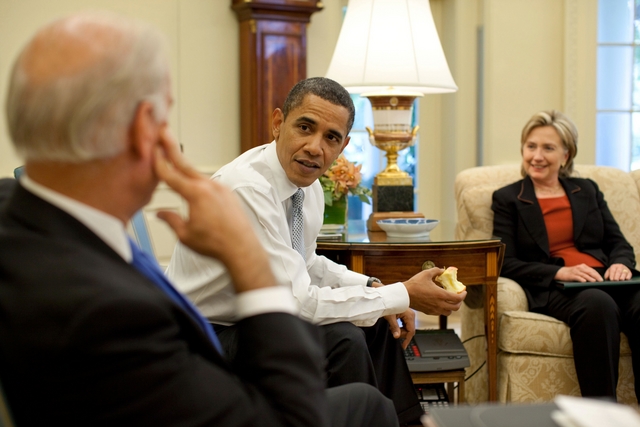 Should the President ask his VP and his Secretary of State to trade jobs? This is one of those too-delicious by half ideas that builds up as beltway buzz and becomes the stuff of gossip columns and talk show chatter. Increasingly however, the idea is not crazy if Obama gets the timing right. It cannot cannot happen mid-term, because under the 25th Amendment, the Republican-controlled House would have to approve the switch — and strengthening the Democratic ticket is not high on Speaker John Boehner’s list of things to do.
Should the President ask his VP and his Secretary of State to trade jobs? This is one of those too-delicious by half ideas that builds up as beltway buzz and becomes the stuff of gossip columns and talk show chatter. Increasingly however, the idea is not crazy if Obama gets the timing right. It cannot cannot happen mid-term, because under the 25th Amendment, the Republican-controlled House would have to approve the switch — and strengthening the Democratic ticket is not high on Speaker John Boehner’s list of things to do.
Why ask them to swap when both Clinton and Biden are by all accounts doing a great job? Mainly because it would revitalize and unify the Democratic ticket, which will face a formidable opposition, contrary to popular wisdom. I don’t know whether the Republicans will nominate Perry or Romney, but I have a pretty good idea of who the short list for VP will be — and Sarah Palin and Michelle Bachman don’t need to wait by the phone.
The strongest VP candidates for Perry or Romney are David Petraeus and Mario Rubio. Petraeus is unlikely to do it. He is a Rockefeller Republican, who Romney could not appoint. He just began a job running the CIA, which takes him out of domestic politics. I hope. He is not Tea Party certified and while he clearly brings huge strengths to any ticket, is not an experienced campaigner (military campaigns don’t count, although the differences are fewer than many realize).
Rubio is a different matter entirely. He is young, son of Cuban exiles, the politically savvy former Speaker of the Florida House, telegenic, and a Senator from a battleground state. He is fully credentialed by the TP crowd. A Romney – Rubio ticket will begin with massive strength in the south and will be very tough to beat in Florida. Romney will play well in the Midwest, where his father was a popular governor, and to conservative parts of New England. Rubio would energize Hispanic voters and extend the Republican base beyond the rich, the pugnacious, and the certifiably looney. It would be a tough ticket to beat — and Obama knows it.
Hillary helps Obama to rally Democrats and Independents. She is a formidable, even relentless, campaigner and she works harder than anyone in politics. It is not simply that she has handled problems in North Korea, Iran, and Israel without upstaging Obama, or that she has been supportive of the president and has been serious, intelligent, and energetic. It’s not just that people in the State Department like her — and some like her a lot — or that she has kept her husband out of the limelight, despite the fears many had. It’s that, unlike Joe, Hillary has a devoted constituency. She draws women, independents, and blue collar voters in much larger numbers than Biden or Obama. She adds deeply to the ticket.
The case for Biden as Secretary of State is also clear: it is the job he has always wanted and he would be very good at it. He was the ranking member and often the chair of the Senate Foreign Relations Committee, he has the requisite rolodex, and he likes diplomacy. He will rely more on personal relationships with foreign leaders than Hillary has, but that’s fine. Biden has built a very solid relationship with Obama and would continue as a senior advisor — a role he enjoys and excels at.
The timing of the Great Swap is constrained by the Constitution. Section 2 of the 25th Amendment states that “Whenever there is a vacancy in the office of the Vice President, the President shall nominate a Vice President who shall take office upon confirmation by a majority vote of both Houses of Congress.” At the moment, that confirmation would be far from assured, so Obama is not likely to ask Biden to resign, appoint Hillary VP, then appoint Biden to State (where his Senate confirmation would be a cake walk). Instead, if he decides to do this, he would plan the move now and nominate Hillary at the convention. Once nominated, Hillary would resign her position and Obama would name Biden to fill it immediately. No House vote needed.
Will Obama make the Great Swap? A lot can go wrong with moves like this — but Obama knows better than anyone that a Presidential campaign requires imagination and energy. Much can and will change before the convention, but we can count on this: Obama is considering this move.
Promising not to promise….
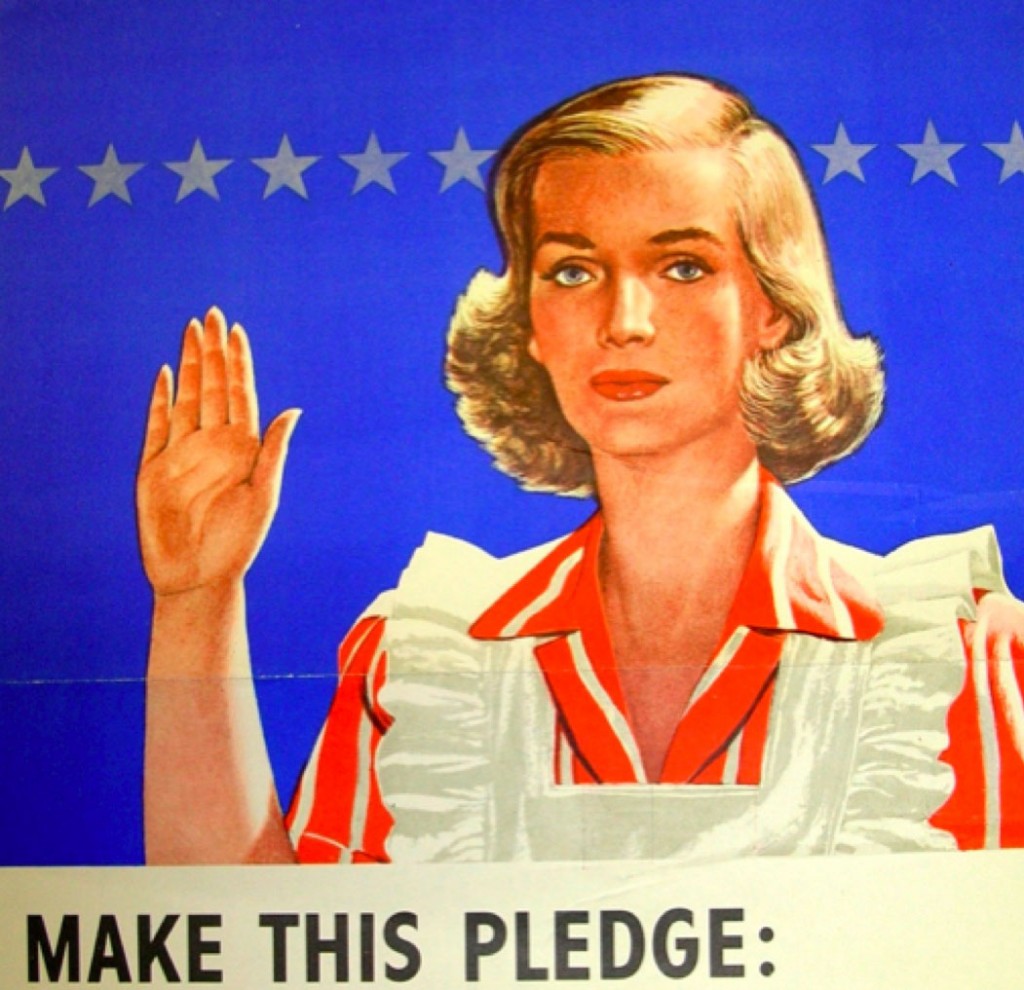 In yesterday's New York Times, Warren Buffett argues that super rich folks should pay higher taxes. Had I asserted that the rich should pay more, it would be an entirely unremarkable example of the famous ditty by Senator Russell Long ("Don't tax me, don't tax thee, tax that fella behind the tree"). These days, you can substitute "cut" for "tax" and make the same point.
But as the world's third richest mogul, Buffett seems to be arguing against his own economic interest. Buffett might assert that higher taxes, a more stable economy, and even less inequality are in the long term economic interest of the super rich. Might be true, but it is still unusual for people to campaign against their short term interests. As a group, his fellow moguls are not only fighting for tax cuts, but for cuts in public spending that will not affect them either. At a minimum, Buffett is showing off the contrarian view that made him rich.
Buffett provides an interesting contrast to Congress, where arguments against interest are as common as snowballs in August. Congress is, by some measures, more divided than at any time in the past 120 years. We badly need Congressional leaders who will argue against their political interest: Democrats who will fight waste, Republicans who will support short term fiscal stimulus. What we get instead is a culture of pledges designed to prevent this.
In yesterday's New York Times, Warren Buffett argues that super rich folks should pay higher taxes. Had I asserted that the rich should pay more, it would be an entirely unremarkable example of the famous ditty by Senator Russell Long ("Don't tax me, don't tax thee, tax that fella behind the tree"). These days, you can substitute "cut" for "tax" and make the same point.
But as the world's third richest mogul, Buffett seems to be arguing against his own economic interest. Buffett might assert that higher taxes, a more stable economy, and even less inequality are in the long term economic interest of the super rich. Might be true, but it is still unusual for people to campaign against their short term interests. As a group, his fellow moguls are not only fighting for tax cuts, but for cuts in public spending that will not affect them either. At a minimum, Buffett is showing off the contrarian view that made him rich.
Buffett provides an interesting contrast to Congress, where arguments against interest are as common as snowballs in August. Congress is, by some measures, more divided than at any time in the past 120 years. We badly need Congressional leaders who will argue against their political interest: Democrats who will fight waste, Republicans who will support short term fiscal stimulus. What we get instead is a culture of pledges designed to prevent this.
- The Tea Party is circulating the short, radical, and malign "Cap, Cut, and Balance" pledge, which has been signed by most Republican presidential candidates.
- Other Tea Party members are circulating a more comprehensive "Contract From America", signed by more than 300 elected leaders.
- The Susan B. Anthony list is circulating an anti-abortion pledge, promising to cut all funding for Planned Parenthood and close all abortion clinics. It was signed by by Michele Bachmann, Newt Gingrich, Ron Paul, Tim Pawlenty and Rick Santorum.
- Most GOP members have signed Grover Norquist's Taxpayer protection pledge
- Norquist is also backing the pledge to support the Parental Rights Amendment, which massages the erogenous zones of the conservative family values crowd
- The American Council for Immigration Reform is circulating a Congressional pledge to oppose amnesty in any form for illegal aliens
- The made for Jon Stewart Marriage Vow promises to to oppose same-sex marriage, reject Shariah law and pledge personal fidelity to their spouse . Good luck with that.
The GOP Raises Interest Rates. China Cheers.
As of tonight, it is not at all clear when the US debt ceiling will get extended or when the entirely artificial crisis caused by Republican House members will be resolved. But one thing is now very clear: the ham-fisted GOP tactics will raise interest costs for every American family and business. It is the economic equivalent of a tax increase -- except that that it increases government expenses, not revenues. These higher interest rates are caused by Congressional flakiness. Interest rates reflect perceived risk -- and China and other lenders now see the US as a lot riskier than we used to be. Real risk is unchanged -- but perceived risk is higher, and that's what counts. The power to punish political stupidity with higher borrowing costs is what once caused Clinton advisor James Carville to announce that in his next life, he wanted to come back as the bond market, since it powerfully influenced all federal economic decisions. It used to anyway. At least one rating agency, S&P, is poised to downgrade US debt. This is unlikely to be calamitous, but it is entirely avoidable and it will needlessly increase US borrowing costs. This makes government more expensive, not less. Worse, it increases interest rates for banks whose borrowing costs that are pegged to Treasuries, which is roughly all of them. It erodes our privilege of serving as the world's reserve currency -- the equivalent of a tax break extended by the world economy to Americans but to no other country. The President of France once termed it an "exorbitant privilege" -- and he was right. This is very likely to end badly for Republicans. There is no economic crisis -- the US is obliged by self-interest, to say nothing of the 14th amendment, to pay all debt obligations. Obama will however, end up paying doctors and soldiers late or with IOUs, like California did a couple of years back. The fractious Republican Party will quickly begin to devour it's Tea Party wing, which has already been denounced by Gingrich, McCain, and Anne Coulter -- hardly left wingers. If the market starts downward, plenty of people will buy stocks because many investors regard the "crisis" as temporary political insanity. Economic fundamentals, although not great and not helped by a spike in interest rates, are also not vastly changed. Treasury bonds have to remain the global fixed-income benchmark because there’s no good alternative. The $9.3 trillion of Treasury securities in circulation is five times more than the total debt of countries like France, Germany, or the UK and the $580 billion of US bonds that trade every day is 17 times higher than UK gilts, the next highest triple-A rated government debt security. The world is learning what every bank knows: if I borrow a small amount from you, I am your debtor, but if I borrow a large amount, I am your partner. Still, Congressional perfidy will cost Americans billions of dollars in needless interest expense. Nobody benefits except banks and China -- the banker to the US government. Perhaps there is after all a reason Speaker John Boener cries so often.Amazon.com: America’s #1 Tax Evader?
== Update:
On September 7, Amazon relented and made a deal to pay sales taxes on shipments to California (no doubt the trenchant analysis that follows persuaded them to do the right thing). For details of the deal see http://goo.gl/kNwjQ.
Now every other state in America needs to make a deal with Amazon -- even if they have fewer than California's 10% of the population. This reinforces the need for Congress to enact a cross-border VAT and to rebate 100% of the funds to the state to which the product ships.
==
Amazon's refusal to collect sales taxes is bad for the company's reputation, bad for honest retailers, and bad for state governments. Six states have taken modest steps to level the tax playing field, causing Amazon to respond with a business, political, and legal offensive to protect its tax-avoidance strategy. The first battleground will be California, where Amazon and national retailers will fight a very expensive ballot initiative. Longer term however, Congress should close the unintended sales tax loophole created by Article I of the US Constitution. Unlike almost every modern country, the US has never had a national sales tax. Most states tax sales within their state but are rightly prevented by the Constitution from taxing out of state transactions. Amazon has turned this important limit on state tax authority into a major piece of its business model. Unfortunately, a smart tactic is becoming a stupid strategy. Congress needs to level its head -- and then level the playing field. From its first day of business, Amazon.com has taken extraordinary measures to avoid collecting sales taxes. It locates distribution centers in low population states to minimize the number of customers for whom it must collect sales taxes. It builds complex software to ensure that every possible product ships across state lines so that customers have no tax obligation. It puts engineers and logisticians to work in shell corporations even if they work on Amazon's retail website just to avoid creating "taxable nexus" -- which obligate Amazon to collect sales taxes. It hires legions of attorneys to minimize and manage the inevitable tax claims. When states like Texas attempt to collect taxes, Amazon retaliates by closing facilities and filing f-you lawsuits. When states declare that Amazon's hundreds of thousands of third party sellers and affiliates amount to a physical presence in the state, Amazon simply closes the programs -- as it did last week in California. Today Amazon went even further: they filed a state ballot initiative in California that will let Californians vote on whether or not to pay sales taxes on third party purchases. National retailers are gearing up for a mammoth fight.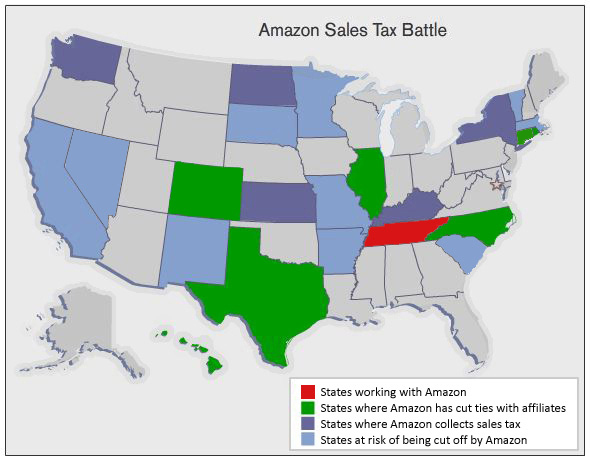
California Turns Green
Read the rest of this entry »
“We are Going to Pass” -10 Reasons VCs Turn Down Startups
 Every few years, Silicon Valley grows strong, flies high, makes beautiful music and then, like the Phoenix of ancient myth, burns to ashes and starts the cycle again. At the moment, the Valley is a frenzy of startups. The rest of the country may be in the economic doldrums, but dozens of technology companies are being formed here every day. Many seek to raise capital and at the moment anyway, money is flowing. Angel and venture investing will surely set new records this year.
During the past two months, I have helped three technology startups raise early stage growth capital and casually advised several others. Each business is in a completely different market: mobile, pharma, cloud computing, crowdsourcing, global communications, etc. Each has unique strengths and weaknesses. The entrepreneurs have wildly different backgrounds and personal qualities.
Not all have completed their funding, but in the process each team has learned similar lessons in how best to approach outside investors (investments from friends, family, and fools doesn’t count. They apply different criteria.) Although I managed to raise tens of millions of dollars for early stage businesses, mainly Alibris, I have personally made most of the mistakes listed here and I have made some of them more than once. Nor is this list particularly unique: investors and experienced entrepreneurs write about them all the time.
So here is my list of the top ten mistakes that entrepreneurs make when they try to raise money from outside investors:
Every few years, Silicon Valley grows strong, flies high, makes beautiful music and then, like the Phoenix of ancient myth, burns to ashes and starts the cycle again. At the moment, the Valley is a frenzy of startups. The rest of the country may be in the economic doldrums, but dozens of technology companies are being formed here every day. Many seek to raise capital and at the moment anyway, money is flowing. Angel and venture investing will surely set new records this year.
During the past two months, I have helped three technology startups raise early stage growth capital and casually advised several others. Each business is in a completely different market: mobile, pharma, cloud computing, crowdsourcing, global communications, etc. Each has unique strengths and weaknesses. The entrepreneurs have wildly different backgrounds and personal qualities.
Not all have completed their funding, but in the process each team has learned similar lessons in how best to approach outside investors (investments from friends, family, and fools doesn’t count. They apply different criteria.) Although I managed to raise tens of millions of dollars for early stage businesses, mainly Alibris, I have personally made most of the mistakes listed here and I have made some of them more than once. Nor is this list particularly unique: investors and experienced entrepreneurs write about them all the time.
So here is my list of the top ten mistakes that entrepreneurs make when they try to raise money from outside investors:
1. No story. Entrepreneurs try to convince investors that they have a winning business – but investors have no idea which businesses will really work. It’s just too complicated. So investors do what human brains are wired to do when confronted with bewildering complexity: they listen for a coherent story. They listen for a particular kind of story that nearly always has three parts: a strong team that achieves impressive traction solving a big problem. These may be called Team has Traction on Trouble or Management has Momentum in a big Market, but to sell your company, you need to tell your version of this story.
Freedom Comes Out
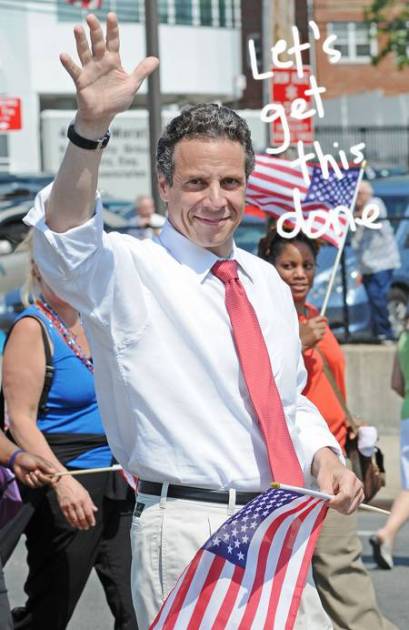 Gay Freedom does not matter yet to most Americans -- but it will, soon enough. Andrew Cuomo's profile in political courage in mobilizing the New York legislature to allow gay marriage is a civil rights landmark. It is also more evidence that public attitudes have tipped. Twenty years from now, people may wonder what the fuss was all about, but today Cuomo deserves our profound thanks. Watch Cuomo in 2016.
One of the great strengths and great weaknesses of humans is that we form tribal attachments. We are drawn to people like ourselves, which allows us to form families, communities, enterprises, and governments. Tribes enable science, education, commerce, and religion. Tribes probably enable language itself.
The problem, of course, is that the bonds that tie can also enslave. Tribes have boundaries and reject those who cross them. They have to or it isn't a tribe. Children have a known tendency to wander from their parent's tribe. Thank God for that -- human progress surely depends on the freedom to form and demolish tribes. In general, the more of both the merrier. Tribes matter -- we cannot and will not do without them -- but they rarely evolve.
Gay freedom is at least in part about the ability of people to re-form or reshape our tribe of birth. Most members of the LGBT tribe were not born into it and most people outside the tribe are nervous about their kids or friends joining it. It's an unusual tribe because, unlike being female, black, or Asian, being gay or lesbian isn't visible. Imagine the history of feminism if first, one had to acknowledge the socially unpopular fact of being female.
This is the context for Tales of the City, the exuberant musical now on at San Francisco's ACT. It is a huge, sprawling, production based on bits from the beloved books by Armistead Maupin. The play, (like The Beginners, featuring George Plummer as a man who comes out at age 75) is saved from a meandering and implausible script by wonderful characters and spectacular acting, just as the music is saved from forgettable melodies by terrific lyrics and enthusiastic performances. I have not enjoyed myself at a musical this much since Avenue Q, (the talented Jeff Whitty wrote the libretto for both).
Even three years ago, following the passage of Prop 8 in California, it was not clear that New York, backed fully by Wall Street and large numbers of business Republicans, would endorse gay marriage. It was very clearly not true in 1976, the setting for Tales of the City. But some small decisions made that year have rippled forward to the present day.
Recall that in 1976, San Francisco mayor George Moscone prevailed in a campaign to legalize homosexuality by repealing California's sodomy laws. That same year, San Francisco was gripped by the trial of Patty Hearst for helping an apparently drug-addled group called the Symbian Liberation Army to rob a bank. Patty was the granddaughter of William Randolf Hearst, the American publishing magnate who printed, among other rags, the San Francisco Chronicle. Then, as now, the Chron was not a real newspaper. We bought it to find out when movies were playing and to read Doonesbury. Also Herb Caen, the irreverent cataloger of left coast life and father of three dot journalism...When interest in the SLA trial began to wane, the editors of the Chronicle decided to try something new: a serialized novel.
Printing a novel in daily installments in the local newspaper was an old idea, not a new one. It is how much of Charles Dickens, first came out (US papers would plagiarize each episode without paying Dickens or his publishers a dime. Made him mad as the dickens...). The Chron ran a column by writer nobody had ever heard of. Armistead Maupin, who called his column Tales of the City.
Gay Freedom does not matter yet to most Americans -- but it will, soon enough. Andrew Cuomo's profile in political courage in mobilizing the New York legislature to allow gay marriage is a civil rights landmark. It is also more evidence that public attitudes have tipped. Twenty years from now, people may wonder what the fuss was all about, but today Cuomo deserves our profound thanks. Watch Cuomo in 2016.
One of the great strengths and great weaknesses of humans is that we form tribal attachments. We are drawn to people like ourselves, which allows us to form families, communities, enterprises, and governments. Tribes enable science, education, commerce, and religion. Tribes probably enable language itself.
The problem, of course, is that the bonds that tie can also enslave. Tribes have boundaries and reject those who cross them. They have to or it isn't a tribe. Children have a known tendency to wander from their parent's tribe. Thank God for that -- human progress surely depends on the freedom to form and demolish tribes. In general, the more of both the merrier. Tribes matter -- we cannot and will not do without them -- but they rarely evolve.
Gay freedom is at least in part about the ability of people to re-form or reshape our tribe of birth. Most members of the LGBT tribe were not born into it and most people outside the tribe are nervous about their kids or friends joining it. It's an unusual tribe because, unlike being female, black, or Asian, being gay or lesbian isn't visible. Imagine the history of feminism if first, one had to acknowledge the socially unpopular fact of being female.
This is the context for Tales of the City, the exuberant musical now on at San Francisco's ACT. It is a huge, sprawling, production based on bits from the beloved books by Armistead Maupin. The play, (like The Beginners, featuring George Plummer as a man who comes out at age 75) is saved from a meandering and implausible script by wonderful characters and spectacular acting, just as the music is saved from forgettable melodies by terrific lyrics and enthusiastic performances. I have not enjoyed myself at a musical this much since Avenue Q, (the talented Jeff Whitty wrote the libretto for both).
Even three years ago, following the passage of Prop 8 in California, it was not clear that New York, backed fully by Wall Street and large numbers of business Republicans, would endorse gay marriage. It was very clearly not true in 1976, the setting for Tales of the City. But some small decisions made that year have rippled forward to the present day.
Recall that in 1976, San Francisco mayor George Moscone prevailed in a campaign to legalize homosexuality by repealing California's sodomy laws. That same year, San Francisco was gripped by the trial of Patty Hearst for helping an apparently drug-addled group called the Symbian Liberation Army to rob a bank. Patty was the granddaughter of William Randolf Hearst, the American publishing magnate who printed, among other rags, the San Francisco Chronicle. Then, as now, the Chron was not a real newspaper. We bought it to find out when movies were playing and to read Doonesbury. Also Herb Caen, the irreverent cataloger of left coast life and father of three dot journalism...When interest in the SLA trial began to wane, the editors of the Chronicle decided to try something new: a serialized novel.
Printing a novel in daily installments in the local newspaper was an old idea, not a new one. It is how much of Charles Dickens, first came out (US papers would plagiarize each episode without paying Dickens or his publishers a dime. Made him mad as the dickens...). The Chron ran a column by writer nobody had ever heard of. Armistead Maupin, who called his column Tales of the City.
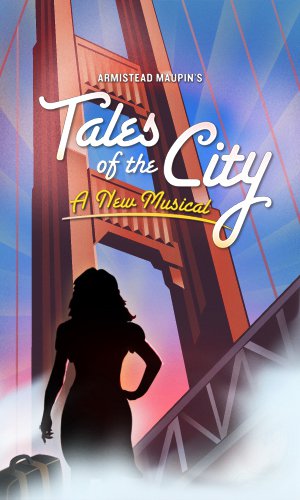 Oh. My. God....the effect was amazing. It was like soap opera -- you hated to miss an installment. Pretty soon you actually cared about the friends and neighbors at Barbary Lane -- the fictional community invented by Maupin. The plots never made any sense (a cult of cannibals at one point took over St. Mary's cathedral on Nob Hill), but it was a helluva lot of fun. And not only that, it was outrageous gay fun -- which at the time seemed considerably more fun than the sort the rest of us were having. This was the year that George Moscone nominated a respected community leader, Jim Jones of the People’s Temple, to San Francisco’s Housing Authority and banned roller-skating on public streets. It was the year that Bob Dylan, Eric Clapton, Joni Mitchell, Neil Young, Van Morrison, Muddy Waters, and Ringo Starr performed "The Last Waltz" with The Band at Winterland, which Martin Scorcese made into a fine movie.
Within two years, Maupin was a successful author and an important voice of a gay community that continued to grow in power. In 1978, the Gay Freedom march drew 250,000 people -- double the size of the San Francisco antiwar marches of a few years earlier. Reaction was swift: orange juice commercial queen Anita Bryant launched a Save the Our Children Campaign, a crusade that received national attention and politically galvanized conservative churches. The gay community retaliated, boycotting Florida Orange Juice, costing Bryant her lucrative endorsements, and driving her into bankruptcy. John Briggs, the Orange County Republican, tried to ban gays from teaching positions in California. But the cause of Gay Freedom seemed only to grow, spreading from San Francisco and New York to major cities around the country and the world.
What could stop this sort of delirious progress? It was a dizzying, naive, and stupid time -- wonderful and amazing to recall. To preserve the momentum hes saw building, Moscone played hardball: he led San Francisco to district elections. This meant that San Franciscans voted by neighborhood. For the first time, they elected a Chinese-American leader, an African American woman, a single mother, and, most incredibly and for the first time in US history, an openly gay man: Harvey Milk of the Castro.
Those who wondered when the progress would end soon found out. San Francisco was forming new tribes and demolishing old ones at a record pace. Some tribes were crazy like SLA wannabes such as the Red Guerrilla Family and the New World Liberation Front. Or the People's Temple. Moscone responded by installing metal detectors in City Hall. But in November, Jim Jones, who had left the Housing Authority and taken his followers to Guyana, killed 900 of them in a mass suicide. Nine days later, Dan White, a disgruntled Irish Catholic cop and former supervisor who had lost out in district elections, assassinated both Moscone and Milk. He avoided Moscone's metal detectors by crawling in through a basement window.
Within three years, gay men were being diagnosed with an illness nobody understood. Doctors knew that it was an immune disorder, but had no idea what triggered it, so they could only call it a syndrome, an acquired immune deficiency syndrome. The disease is now a global pandemic and has killed more than thirty million people. Nearly two million people die from AIDS each year, even though it is now a disease that can be medically managed. I can think of no social movement in human history that has been so disproportionately affected by a contagious illness that targets its members. AIDS slowed the cause of gay rights by at least twenty years.
Which makes this week's victory all the more powerful. Liberty and the pursuit of happiness cannot happen in a closet and often cannot happen in one's tribe of birth. Those who care about freedom, and that is a very large group, need to defend the freedom of all people to define, discover, and celebrate their own identity at least as vigorously as we protect our ability to form tribes.
Oh. My. God....the effect was amazing. It was like soap opera -- you hated to miss an installment. Pretty soon you actually cared about the friends and neighbors at Barbary Lane -- the fictional community invented by Maupin. The plots never made any sense (a cult of cannibals at one point took over St. Mary's cathedral on Nob Hill), but it was a helluva lot of fun. And not only that, it was outrageous gay fun -- which at the time seemed considerably more fun than the sort the rest of us were having. This was the year that George Moscone nominated a respected community leader, Jim Jones of the People’s Temple, to San Francisco’s Housing Authority and banned roller-skating on public streets. It was the year that Bob Dylan, Eric Clapton, Joni Mitchell, Neil Young, Van Morrison, Muddy Waters, and Ringo Starr performed "The Last Waltz" with The Band at Winterland, which Martin Scorcese made into a fine movie.
Within two years, Maupin was a successful author and an important voice of a gay community that continued to grow in power. In 1978, the Gay Freedom march drew 250,000 people -- double the size of the San Francisco antiwar marches of a few years earlier. Reaction was swift: orange juice commercial queen Anita Bryant launched a Save the Our Children Campaign, a crusade that received national attention and politically galvanized conservative churches. The gay community retaliated, boycotting Florida Orange Juice, costing Bryant her lucrative endorsements, and driving her into bankruptcy. John Briggs, the Orange County Republican, tried to ban gays from teaching positions in California. But the cause of Gay Freedom seemed only to grow, spreading from San Francisco and New York to major cities around the country and the world.
What could stop this sort of delirious progress? It was a dizzying, naive, and stupid time -- wonderful and amazing to recall. To preserve the momentum hes saw building, Moscone played hardball: he led San Francisco to district elections. This meant that San Franciscans voted by neighborhood. For the first time, they elected a Chinese-American leader, an African American woman, a single mother, and, most incredibly and for the first time in US history, an openly gay man: Harvey Milk of the Castro.
Those who wondered when the progress would end soon found out. San Francisco was forming new tribes and demolishing old ones at a record pace. Some tribes were crazy like SLA wannabes such as the Red Guerrilla Family and the New World Liberation Front. Or the People's Temple. Moscone responded by installing metal detectors in City Hall. But in November, Jim Jones, who had left the Housing Authority and taken his followers to Guyana, killed 900 of them in a mass suicide. Nine days later, Dan White, a disgruntled Irish Catholic cop and former supervisor who had lost out in district elections, assassinated both Moscone and Milk. He avoided Moscone's metal detectors by crawling in through a basement window.
Within three years, gay men were being diagnosed with an illness nobody understood. Doctors knew that it was an immune disorder, but had no idea what triggered it, so they could only call it a syndrome, an acquired immune deficiency syndrome. The disease is now a global pandemic and has killed more than thirty million people. Nearly two million people die from AIDS each year, even though it is now a disease that can be medically managed. I can think of no social movement in human history that has been so disproportionately affected by a contagious illness that targets its members. AIDS slowed the cause of gay rights by at least twenty years.
Which makes this week's victory all the more powerful. Liberty and the pursuit of happiness cannot happen in a closet and often cannot happen in one's tribe of birth. Those who care about freedom, and that is a very large group, need to defend the freedom of all people to define, discover, and celebrate their own identity at least as vigorously as we protect our ability to form tribes.
Kwik Fixin’ Oakland
I love Oakland. It is immigrant, black, and blue collar. The town has a great history and a solid soul. Ours were among the first neighborhoods in America where all of the whites did not move out when blacks moved in.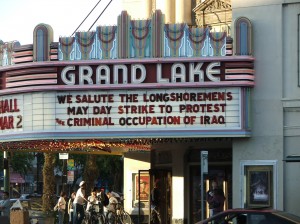 Of course, along with a heart of oak, the town also has a brain of well mashed potatoes. We celebrate diversity beyond parody and indulge in thousand clown politics "somewhere to the left of whoopee!". Our schools work with immigrant kids that show up speaking more than two dozen languages (actually, nobody speaks two dozen languages. That's the problem. Each kid speaks one. A different one). Like our libraries, these schools are collapsing under the weight of dodgy managers, paleolithic unions, and ineffective parents (not necessarily indifferent, just collectively ineffective outside of Crocker Highlands).
My part of town, near Lake Merritt, has been brought together by a weekend farmer's market and by the perpetual comedy of the Grand Lake Theater billboard (typical offering: "Prosecute Dick Cheney for torture" followed by "Kick Ass II").
We have a terrific neighborhood association which, like most neighborhood associations, is where liberals go to be conservative. Ours is earnestly opposed to rich corporations. And to poor corporations. But perhaps not to Trader Joe's, because they are German and cool. Also not to Peets, because he was Dutch, their coffee is cool, and they come from Berkeley. (Starbucks: you are clearly suspect). We like "small local businesses" because they are so small and local. The Gap is a dilemma. It is local, but not small -- so like Starbucks, we tolerate but do not embrace. What matters here is not whether you create stable, well-paying jobs with health care benefits or even whether you deliver useful goods or services. What matters most in Oakland is that you are small, local, and (ideally) ethnic. Our motto: we love you. Unless you succeed.
Which pretty much rules out McDonalds. In 2004, the Golden Arches wanted to take over Kwik Way, a burger joint that had been abandoned for years. In 1980, Commander Cody and his Lost Planet Airmen memorialized Kwik Way in "Two Triple Cheese" on their Lose it Tonight album. The lyrics suggest that the Commander lived in this part of town, even if he takes liberties with the street names. His ode to saturated fat, salt, and cholesterol now enjoys a place of honor in the permanent collection of the Museum of Modern Art in NYC. Watch it below: it's pretty good.
Post Cody, the Kwik Way became an abandoned dump and a favorite haunt of sketchy crackheads who sold stuff in plastic tubes and left them lying all over the massive drive-in parking lot. McDonalds offered to renovate the place, hire local kids to run it, and keep it swept up. The arches might have framed the Grand Lake Theater quite nicely, but no way. The 'hood mobilized against the would be corporate trespassers. Conveniently ignoring the KFC next door, we stopped Big Mac by asserting that the traffic would snarl up the place (we argued, in short, that "we gotta stop this restaurant because it might be so popular").
Gleeful idiocy of this sort mixed with strong coffee is what keeps Oakland running. Truly if you polled my neighbors, 65% would nod solemnly at the assertion that McDonalds was responsible for Dick Cheney and his Guantanamo torture. (The sordid truth, of course, is that McDonalds has killed more people than Dick Cheney ever dreamed of and quite likely contributed to the Veep's own lousy ticker. But the Oaklandish among us objected to the crowds that McDonalds would attract, not to the celebrated American tradition of serving cardiotoxins to teenagers.)
Kwik Way crumbled until it was finally sold to a local developer with an appreciation of mauve, ecru, and other soothing colors. He relaunched it as a higher priced burger joint a couple of weeks ago. The place sells food that is arguably more salty, fatty, and sugared than McDonalds, but hey, it is small and local. Here is a video of the opening (a prime specimen of neighborhood values appears at the 1 minute mark).
Comparing the two videos, who wants to argue that we have made real progress?
Of course, along with a heart of oak, the town also has a brain of well mashed potatoes. We celebrate diversity beyond parody and indulge in thousand clown politics "somewhere to the left of whoopee!". Our schools work with immigrant kids that show up speaking more than two dozen languages (actually, nobody speaks two dozen languages. That's the problem. Each kid speaks one. A different one). Like our libraries, these schools are collapsing under the weight of dodgy managers, paleolithic unions, and ineffective parents (not necessarily indifferent, just collectively ineffective outside of Crocker Highlands).
My part of town, near Lake Merritt, has been brought together by a weekend farmer's market and by the perpetual comedy of the Grand Lake Theater billboard (typical offering: "Prosecute Dick Cheney for torture" followed by "Kick Ass II").
We have a terrific neighborhood association which, like most neighborhood associations, is where liberals go to be conservative. Ours is earnestly opposed to rich corporations. And to poor corporations. But perhaps not to Trader Joe's, because they are German and cool. Also not to Peets, because he was Dutch, their coffee is cool, and they come from Berkeley. (Starbucks: you are clearly suspect). We like "small local businesses" because they are so small and local. The Gap is a dilemma. It is local, but not small -- so like Starbucks, we tolerate but do not embrace. What matters here is not whether you create stable, well-paying jobs with health care benefits or even whether you deliver useful goods or services. What matters most in Oakland is that you are small, local, and (ideally) ethnic. Our motto: we love you. Unless you succeed.
Which pretty much rules out McDonalds. In 2004, the Golden Arches wanted to take over Kwik Way, a burger joint that had been abandoned for years. In 1980, Commander Cody and his Lost Planet Airmen memorialized Kwik Way in "Two Triple Cheese" on their Lose it Tonight album. The lyrics suggest that the Commander lived in this part of town, even if he takes liberties with the street names. His ode to saturated fat, salt, and cholesterol now enjoys a place of honor in the permanent collection of the Museum of Modern Art in NYC. Watch it below: it's pretty good.
Post Cody, the Kwik Way became an abandoned dump and a favorite haunt of sketchy crackheads who sold stuff in plastic tubes and left them lying all over the massive drive-in parking lot. McDonalds offered to renovate the place, hire local kids to run it, and keep it swept up. The arches might have framed the Grand Lake Theater quite nicely, but no way. The 'hood mobilized against the would be corporate trespassers. Conveniently ignoring the KFC next door, we stopped Big Mac by asserting that the traffic would snarl up the place (we argued, in short, that "we gotta stop this restaurant because it might be so popular").
Gleeful idiocy of this sort mixed with strong coffee is what keeps Oakland running. Truly if you polled my neighbors, 65% would nod solemnly at the assertion that McDonalds was responsible for Dick Cheney and his Guantanamo torture. (The sordid truth, of course, is that McDonalds has killed more people than Dick Cheney ever dreamed of and quite likely contributed to the Veep's own lousy ticker. But the Oaklandish among us objected to the crowds that McDonalds would attract, not to the celebrated American tradition of serving cardiotoxins to teenagers.)
Kwik Way crumbled until it was finally sold to a local developer with an appreciation of mauve, ecru, and other soothing colors. He relaunched it as a higher priced burger joint a couple of weeks ago. The place sells food that is arguably more salty, fatty, and sugared than McDonalds, but hey, it is small and local. Here is a video of the opening (a prime specimen of neighborhood values appears at the 1 minute mark).
Comparing the two videos, who wants to argue that we have made real progress?
Nostalgia: Not as Seductive as it Used to Be.

With my wife grounded by a nasty ankle injury, we took in three movies and I escaped to a rock band reunion. Oddly, they all confirmed the same lesson: nostalgia is a temptress -- fun, but wholly unreliable.
Owen Wilson is the hero of Woody Allen's new movie, Midnight in Paris. He is a Hollywood screenwriter working on a piece about a nostalgia dealer even as he visits Paris and is transported in style back to the Lost Generation of the 1920s and 30s. The film is complete with a hysterical Hemmingway, a brilliant Stein, and appearances by Dali, Picasso, and both Fitzgeralds. It is a romp -- the sort of film that Allen made in the good old days before he married his step-daughter.
Allen understands that mature cities are built on memories -- perhaps Paris most of all. Memory is impossible in emerging cities (in Beijing today, the drivers frequently get lost because entire neighborhoods are transformed so thoroughly that they seem foreign). Mature cities are often wealthy enough to be politically liberal but most are culturally conservative, even as they attract the great minds of every age. Inevitably, the Golden Age of any great city is thus built by people who idolize an earlier Golden Age. Into this vortex steps Wilson, a Texan version of the traditional Woody Allen romantic, neurotic schlurb. It all works well, with the obvious exception of Carla Bruni, who should stick to her day job as the first lady of France. (Unable to cut her from the film altogether, Allen simply created a new character, wonderfully played by Lea Seadoux, to take over 90% of the role offered to the hopelessly wooden Bruni). 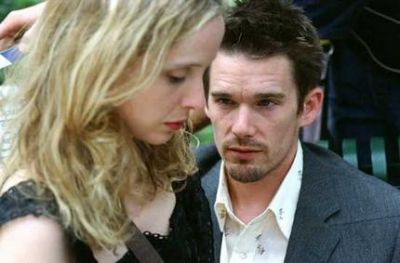
We also treated ourselves to a pair of movies I passed on when they first came out but have since been told by many constitute the best romance films ever made: Before Sunrise and Before Sunset. Both films consist almost entirely of conversation between Ethan Hawke and Julie Delpy. Once again, there are ties to Paris and nostalgia, and some of the ties are subtle. For example, the second film opens at Shakespeare and Company, the famous bookstore founded by Sylvia Plath and frequented by Hemmingway, Dos Passos, and other characters out of Midnight in Paris. Plath famously published James Joyce's Ulysses, which takes place on a single day, June 16, Dublin. Before Sunrise takes place during a single day in Vienna and ends with our two lovers agreeing to reunite in Paris the following summer on, you guessed it, June 16. The second film opens with viewers wondering whether either had shown up. The movies are wonderfully rendered, brilliantly acted, and an ode to the trap of powerful memory, especially powerful romantic memories. Very highly recommended and available for streaming on Netflix.
On the advice of a friend, I caught the Buffalo Springfield reunion concert down the street at Oakland's the newly restored Fox Theater. The theater is beautiful, but tells a powerful political tale. It was refurbished by Jerry Brown as mayor using redevelopment money, despite the Paramount, a landmark Art Deco theater one block away. The Paramount was empty the night of the Springfield reunion -- and Jerry Brown is now proposing, quite rightly, to eliminate California's wasteful, zero-sum, redevelopment spending.
The Springfield are nothing these days if not nostalgic. The concert opened with On The Way Home: "When the dream came, I held my breath with my eyes closed", which pretty much described the graying, cannabis-mellow crowd.
Buffalo Springfield reminded me of the new atomic elements reported in today's Times. Like all of the heavy particles, it is highly unstable and blows apart after a split second. The three founders still seem deeply incompatible. Stephen Stills is a classic rocker and always has been. He looked pretty good, he has lost some weight, but he can no longer sing. Furay is a pop singer, good at the girl songs, who should have joined the Eagles. He can sing, but his guitar playing is like a guy leading church camp. Which figures, since Furay has been a Christian minister for the past three decades, but apparently needs another 15 minutes of rock star fame.
Then there is Neil Young (who Stills once wrongly accused of being "a folk singer who wants to play in a rock band"). Young is just more talented, more committed, and all around more bad ass than Stills or Furay. Young played off to one side, but the stage always tipped his way. In the encore, he broke loose and lit up the place with Keep on Rocking in the Free World, which revealed Stills and Furay to be what they always were: Young's backup band. The idea that these guys in their 20s and on drugs even practiced together, never mind made albums and toured, is hard to imagine. The reunion produced some memorable music, but ultimately no nostalgia can overcome the core incompatibility of the band's founders, who stayed together less than two years.

